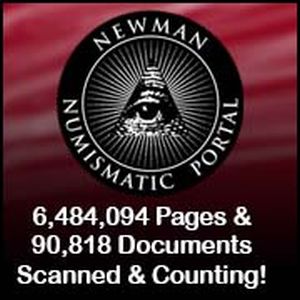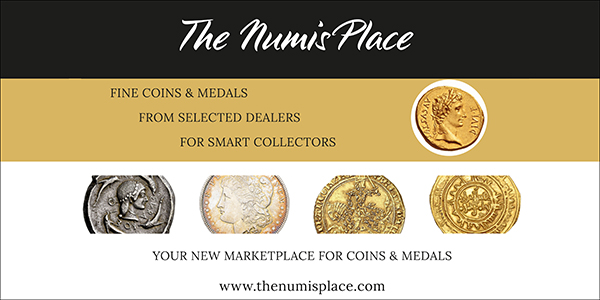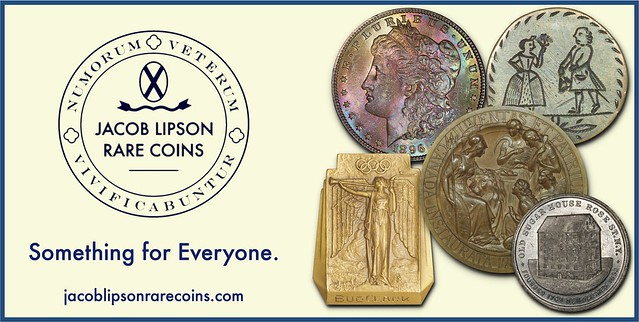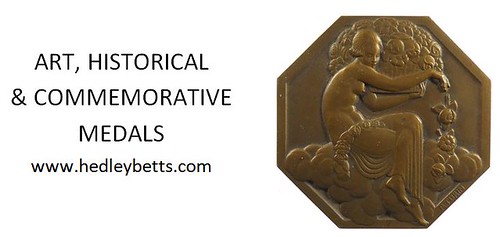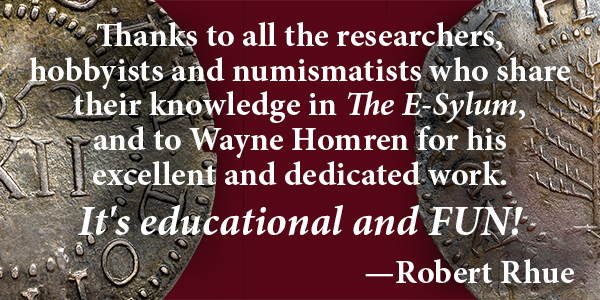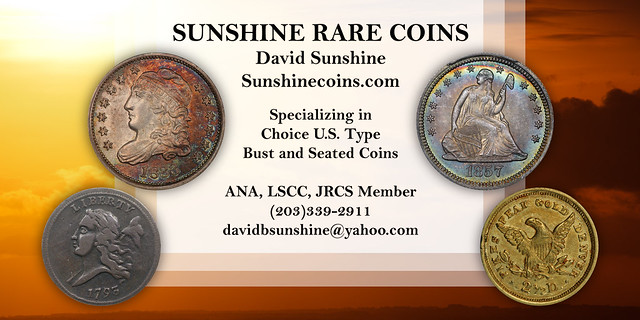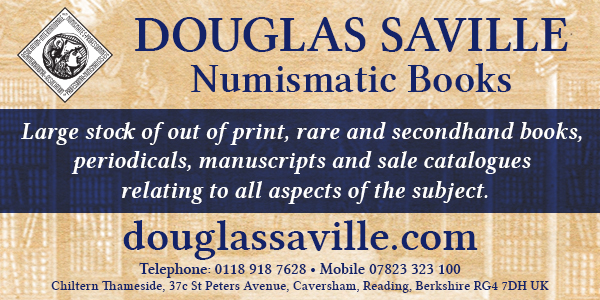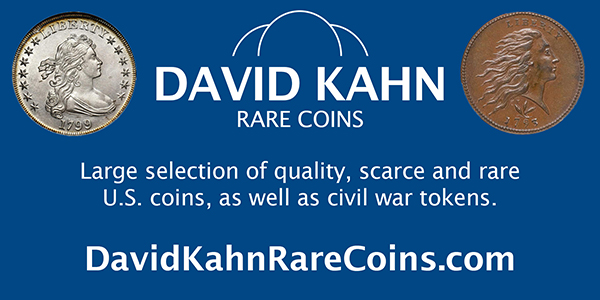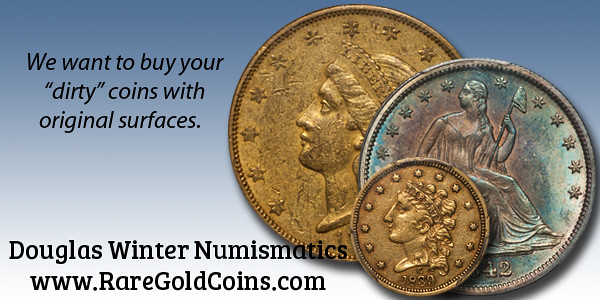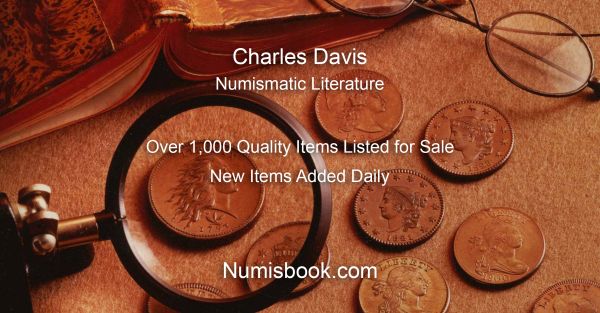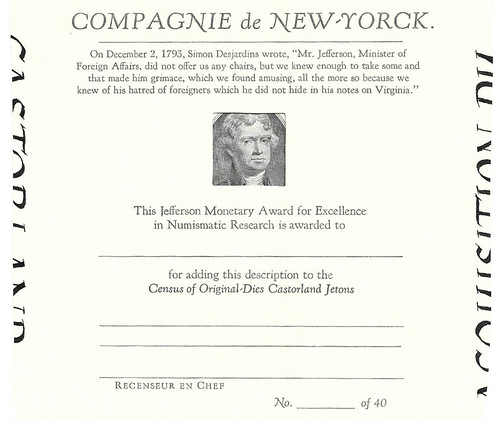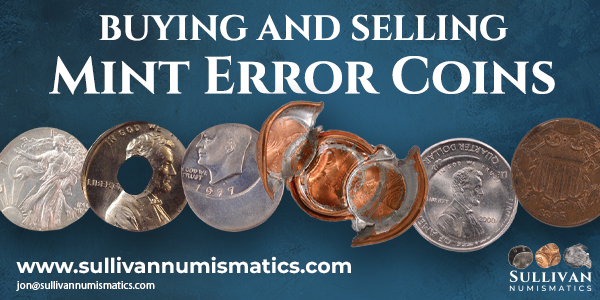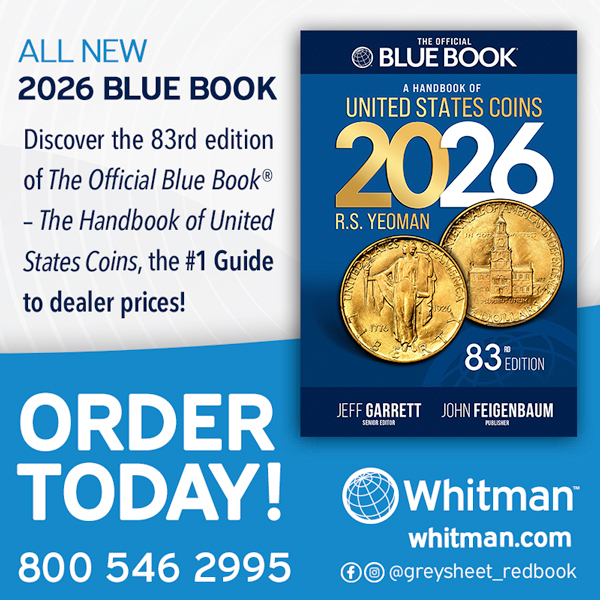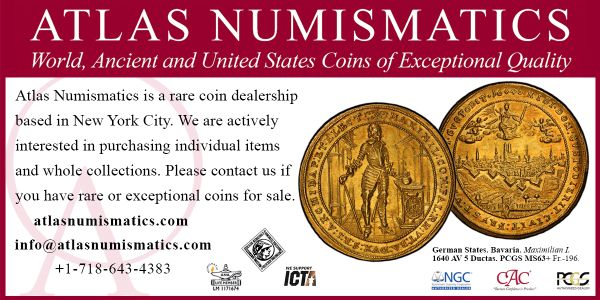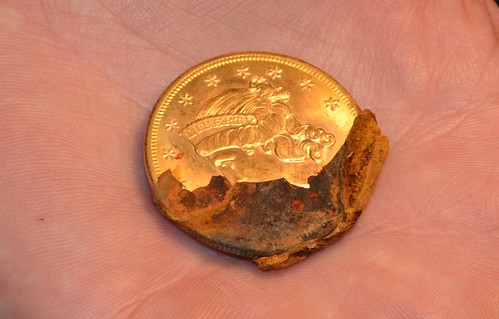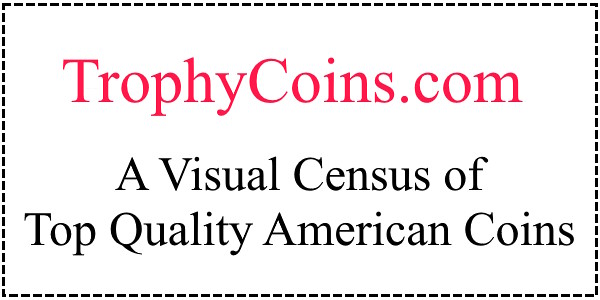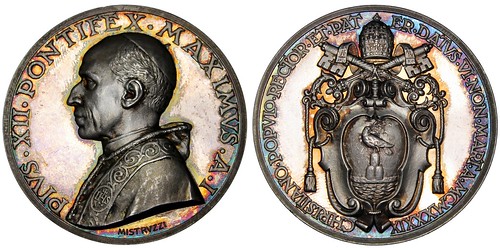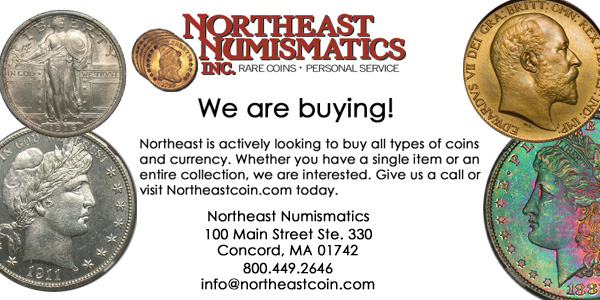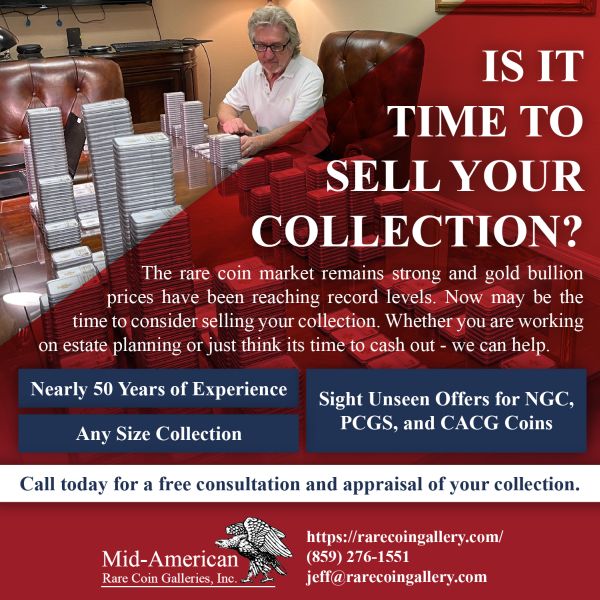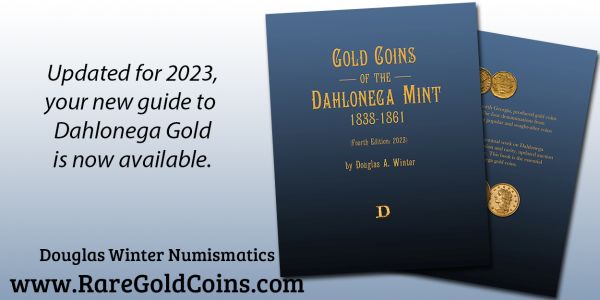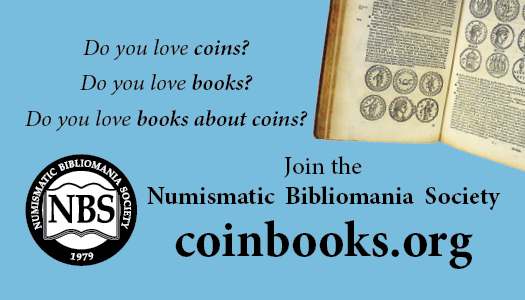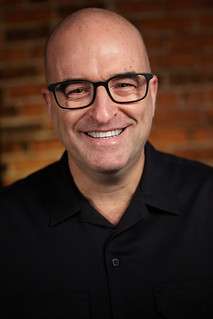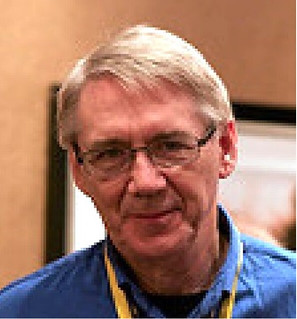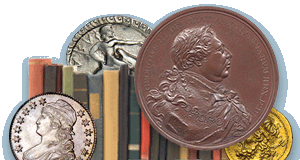
Visit our NBS Sponsors
About UsThe Numismatic Bibliomania Society is a non-profit association devoted to the study and enjoyment of numismatic literature. For more information please see our web site at coinbooks.org SubscriptionsThose wishing to become new E-Sylum subscribers (or wishing to Unsubscribe) can go to the following web page link MembershipThere is a membership application available on the web site Membership Application To join, print the application and return it with your check to the address printed on the application. Print/Digital membership is $40 to addresses in the U.S., and $60 elsewhere. A digital-only membership is available for $25. For those without web access, write to: Jeff Dickerson, Treasurer AsylumFor Asylum mailing address changes and other membership questions, contact Jeff at this email address: treasurer@coinbooks.org SubmissionsTo submit items for publication in The E-Sylum, write to the Editor at this address: whomren@gmail.com BUY THE BOOK BEFORE THE COINSale Calendar
|
- WAYNE'S WORDS: THE E-SYLUM MAY 11, 2025
- NBS 2025 CHARITY AUCTION DONATIONS SOUGHT
- KOLBE & FANNING MAY 2025 SALE ANNOUNCED
- NEW BOOK: THE FIRST MEXICAN CENT OF 1841
- NEW BOOK: MALTESE TOKENS
- NEW BOOK: MILLIONAIRES OF THE WESTERWALD
- PERIODICAL: MCA ADVISORY SPRING 2025
- PERIODICAL: PAPER MONEY, MAY-JUNE 2025
- NNP SCANS U.S. MINT MARKETING MATERIALS
- 2025 NNP SYMPOSIUM VIDEOS AVAILABLE
- VIDEO: GETTING KIDS INVOLVED IN COIN COLLECTING
- ANS AMERICA 250 MEDAL PROJECT DONATIONS SOUGHT
- MAY 2025 PAN SHOW EVENTS
- THE CROWNED F 'FOREIGNER'S MARK'
- NOTES FROM E-SYLUM READERS: MAY 11, 2025
- CASTORLAND SCAVENGER HUNT ANNOUNCED
- A 100 GREATEST U.S. COINS COLLECTION
- VOCABULARY TERM: RESTRIKE
- WILLIAM HESSLEIN (1868-1932)
- TREASURE TALK WITH BOB EVANS, EPISODE 4.2
- NUMISMAGRAM MEDAL SELECTIONS: MAY 11, 2025
- KUENKER TO SELL RONUS COLLECTION FOR ANS
- NOMOS TO SELL COLLIER COLLECTION FOR ANS
- VULCAN ON ANCIENT COINS
- SEDE VACANTE COINS
- HOBO NICKEL FLAPPER CARVINGS
- WAR MUSEUM EXTENDS VICTORIA CROSS EXHIBIT
- MOTHER'S DAY NUMISMATICS
- UNEXCHANGED SWISS BANKNOTE FUNDS
- LOOSE CHANGE: MAY 11, 2025
- ABOUT THIS ISSUE: MAY 11, 2025
Content presented in The E-Sylum is not necessarily researched or independently fact-checked, and views expressed do not necessarily represent those of the Numismatic Bibliomania Society.
WAYNE'S WORDS: THE E-SYLUM MAY 11, 2025
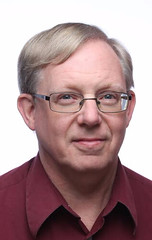 Thank you for reading The E-Sylum. If you enjoy it, please send me the email addresses of friends you think may enjoy it as well and I'll send them a subscription. Contact me at whomren@gmail.com anytime regarding your subscription, or questions, comments or suggestions about our content.
Thank you for reading The E-Sylum. If you enjoy it, please send me the email addresses of friends you think may enjoy it as well and I'll send them a subscription. Contact me at whomren@gmail.com anytime regarding your subscription, or questions, comments or suggestions about our content.
This week we open with the annual NBS Charity Auction, a numismatic literature sale, three new books, two periodicals (and in lieu of a partridge in a pear tree), updates from the Newman Numismatic Portal, ANS, and more.
Other topics this week include Maltese tokens, U.S. Mint marketing materials, the NNP Symposium, the PAN Show, Foreigner's Marks, restrikes, William Hesslein, fixed price and auction selections, Vulcan on ancient coins, Sede Vacante coins, Mother's Day numismatics, and flappers on Hobo Nickels.
To learn more about an original subscription set of Sylvester Crosby's The Early Coins of America, the 1841 Mexican cent, the massive 1976 National Bicentennial Medal, the Great Kentucky Hoard, North American Indian Peace Medals, 1838-O Half Dollars, Castorland Jetons, the Ronus Collection, and the Book of Armaments, read on. Have a great week, everyone!
Wayne Homren
Editor, The E-Sylum
NBS 2025 CHARITY AUCTION DONATIONS SOUGHT
Each year at the ANA World's Fair of Money, the Numismatic Bibliomania Society conducts a charity auction to raise funds for the organization. NBS President Len Augsburger submitted this announcement of this year's auction. Thanks! -Editor
NBS Solicits Donations for Annual Charity Auction
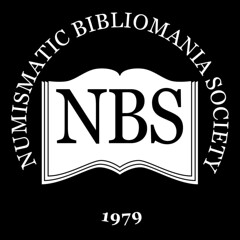 Once again, NBS will present a Charity Auction fundraiser at the Oklahoma City ANA convention. This will occur Friday, August 22, during the NBS general meeting. Anyone interested in donating material may contact David Fanning (df@numislit.com) or Len Augsburger (leonard.augsburger@wustl.edu) for further information.
Once again, NBS will present a Charity Auction fundraiser at the Oklahoma City ANA convention. This will occur Friday, August 22, during the NBS general meeting. Anyone interested in donating material may contact David Fanning (df@numislit.com) or Len Augsburger (leonard.augsburger@wustl.edu) for further information.
While literature of varying values is welcome, we encourage donation of items valued at $100 and up. Highlights from last year included the Eric P. Newman library card catalog, which realized $1,600, while a 1957 prices paid for list from the Bowers Coin Company drew $650.
To read the earlier E-Sylum article, see:
2024 NBS CHARITY AUCTION RESULTS
(https://www.coinbooks.org/v27/esylum_v27n33a02.html)
THE BOOK BAZARRE
KOLBE & FANNING MAY 2025 SALE ANNOUNCED
Kolbe & Fanning have announced their next numismatic literature sale, featuring books on ancient, world and U.S. numismatics. -Editor
 Kolbe & Fanning Numismatic Booksellers are pleased to announce that we will be holding our
next auction sale on Saturday, May 31, 2025. The sale includes rare and out-of-print works on
ancient, world and U.S. numismatics, including the second half of the L.D. & I.P. Library and
additional selections from the library of Barry Tayman. With 500 lots, there is something for
everybody.
Kolbe & Fanning Numismatic Booksellers are pleased to announce that we will be holding our
next auction sale on Saturday, May 31, 2025. The sale includes rare and out-of-print works on
ancient, world and U.S. numismatics, including the second half of the L.D. & I.P. Library and
additional selections from the library of Barry Tayman. With 500 lots, there is something for
everybody.
Some highlights of the sale include:
Lot 52: a set of Calciati's magnificent Pegasi, accompanied by original prints (signed and numbered) of art used in the book
Lot 111: the 1912 Hess catalogues of the Tolstoï and Prowe collections of Roman Republican coins, bound together in contemporary maroon half Morocco
Lot 69: Raymond & Charles Dupriez's own set of their catalogues, comprising some 118 catalogues bound in over twenty volumes, including many named sales and rarities
Lot 169: André de Ritter's folio catalogue of the engraved gems in the Louis De Clercq collection, one of a number of books on engraved gems offered from the Pierre Bastien library
Lot 242: M. de Bettange's significant 1760 work on coining, Traité des monoyes, as issued in two volumes and in a contemporary mottled calf binding
Lot 273: a complete hardcover set of Jeffrey Hoare auction catalogues, 1986–2007, comprising seventy-three catalogues bound in twenty-two volumes
Lot 312: the 1730 London edition of The Hibernian Patriot, being Jonathan Swift's anonymously published Drapier's Letters against the coinage of William Wood in Ireland
Lot 359: a very rare plated copy of S.H. Chapman's 1920 catalogue of the W.H. Hunter collection, one of only a small number of copies known with 9 superb photographic plates
Lot 370: an original subscription set of Sylvester Crosby's The Early Coins of America, as issued in separate fascicles and still in the original printed paper covers
Lot 395: Eric P. Newman and Burdette Johnson's records of their acquisition and disposition of the Colonel E.H.R. Green collection, one of the most important archives in American numismatic history.
WOW! Original unbound copies of Crosby are rare and important numismatic history - this book set the standard and is still referenced today. And the disposition of the legendary Colonel E.H.R. Green collection is a story for the ages. I'm sure both lots will see spirited bidding. -Editor
Bids may be placed via post, email or phone, as well as online. Kolbe & Fanning use Auction Mobility as our third-party online bidding platform. Auction Mobility is an app-based platform allowing users the ability to participate in the sale through phones, tablets and computers. To register for the sale, bidders must go to bid.numislit.com and sign up. Once you have set up an account, you may browse lots, place advance bids, or participate in the live sale online. Those wishing to participate on their devices can download the Kolbe & Fanning app through the Apple or Google Play Store. The sale will also be listed on Biddr and NumisBids in the near future.
The printed catalogue is being mailed to all active customers on our mailing list. As international mail speeds have been inconsistent, we encourage our foreign clients to consult the electronic catalogue in case their printed catalogue does not arrive promptly. A PDF of the printed catalogue has been posted to our main website at numislit.com for those who prefer that format. Bids placed via post, email, fax or phone must be received by May 30, the day before the sale, in order for them to be processed. Advance absentee bids may also be placed at any time online at bid.numislit.com. Live internet bidding will be available during the sale itself through the same platform.
Kolbe & Fanning Numismatic Booksellers LLC, is licensed by the State of Ohio Department of Agriculture (license 2025000025) as an auctioneer, and is bonded as required by law in favor of the State of Ohio.
For more information, please see the Kolbe & Fanning website at numislit.com or email David Fanning at df@numislit.com. To register for the sale, go to bid.numislit.com. We look forward to your participation.
NEW BOOK: THE FIRST MEXICAN CENT OF 1841
Pablo Luna Herrera has published a new book on Mexican pattern coins and a unique coin, the 1841 cent. Congratulations! -Editor
I am writing to inform you of the publication of my latest book, which specializes in Mexican pattern coins.
The investigation focuses on a unique coin, the 1841 cent, which is highly symbolic due to its significance in the history of Mexican currency. It is the first manifestation of the decimal currency system in Mexico, more than twenty years before the successful introduction of centavo coins. The investigation reveals new information about this coin, much of which has never been previously disclosed.
The book is available in both softcover and hardcover, and in a bilingual edition in English and Spanish, which includes color illustrations. The commercialization of the book is being led by the auction house "Briggs & Bustos." If you are interested in purchasing the book, please send an email to admin@bbacutions.com.mx and amb@bbauctions.com.mx .
NEW BOOK: MALTESE TOKENS
Yosef Sa'ar passed along this information about a new book on the tokens of Malta. Thank you! -Editor
Maltese Tokens a collection
Jeanette e Stivala née McLarty, Tony Stivala
 This publication is about tokens used in Malta during the British period, mainly from the late Victorian period to the 1960s. The Stivalas have managed to find a good number of tokens since Lyall's 1999 publication, in which 95 different establishments had been identified. This publication identifies no less than 84 new establishments, most of which are new or different to those already identified by Lyall.
This publication is about tokens used in Malta during the British period, mainly from the late Victorian period to the 1960s. The Stivalas have managed to find a good number of tokens since Lyall's 1999 publication, in which 95 different establishments had been identified. This publication identifies no less than 84 new establishments, most of which are new or different to those already identified by Lyall.
These Malta ‘tokens', in their various forms and intended use, tell the economic and social history of Malta, albeit, at times, verging on the shady side. Nevertheless, it is a Malta story which these tokens help to commemorate and immortalize. Tony and Jeanette Stivala deserve our compliments for publishing such a rare collection and research for everyone's enjoyment and perusal, a most welcome addition to Melitensia collections and publications.
For more information, or to order, see:
Maltese Tokens a collection
(https://horizons.com.mt/product/maltese-tokens-a-collection/)
Here's an article about the book and its authors. -Editor
 Tony Stivala and his Scottish wife Jeanette, née McLarty, have been collecting tokens, as well as many other Maltese artefacts, for about 20 years and have recently published a book on their endeavour.
Tony Stivala and his Scottish wife Jeanette, née McLarty, have been collecting tokens, as well as many other Maltese artefacts, for about 20 years and have recently published a book on their endeavour.
They became interested in these items quite by chance.
One day, an English collector came to our bar and asked me if I had any tokens,
said Mr Stivala, who runs Times Gone By in Gzira.
"I was instantly intrigued and being an avid collector of Maltese memorabilia, I thought ‘why don't I start collecting them myself'?"
His wife helped him with the research and found, among other things, that tokens were first used in Malta during the time of the Order of St John but became especially popular during the British period. The book, published by Horizons, in fact focuses on the late Victorian era to the 1960s.
"Tokens were used quite profusely at the time. There was a lack of coinage owing to the increase in the number of visitors to the island, especially navy and army personnel, who frequented entertainment spots across the island," noted Ms Stivala, who is from Northfield in Aberdeen.
As Emmanuel Magro Conti, senior curator at Heritage Malta, explains in the book's foreword, the use of tokens instead of the official legal tender issued by the government forms part of ‘exonumia', a term that incorporates all numismatic items made of various materials, sizes and shapes other than official coins and paper money.
The couple managed to find tokens of innumerable bars in Strait Street, such as the Blue Heaven, British Crown Rest Bar, Dirty Dick's Bar, which was popular among the gay community, King George VI Bar, Queen Elizabeth Bar, Sussex Bar, Matador Jazz Bar, Piccadilly Bar, Retainer Bar, Roy Bar and The Splendid Bar & Hotel, which is sometimes used as an exhibition space nowadays.
During the 1930s, churchgoers in Zejtun also had to use tokens to pay for the use of a chair in their parish church, while worshippers at St Paul's Anglican Cathedral in Valletta made tokens in memory of deceased loved ones and the money collected went towards the cathedral.
To read the complete article, see:
Tokens that tell a way of life
(https://timesofmalta.com/article/tokens-that-tell-a-way-of-life.700450)
NEW BOOK: MILLIONAIRES OF THE WESTERWALD
A new book by Uwe Bronnert is a monetary history of Germany's Westerwald region. Here's a Google-translated excerpt from an article from the Geldscheine Online newsletter. -Editor
 The Millionaires of the Westerwald
The Millionaires of the Westerwald
A regional monetary history
By Uwe Bronnert
What the author, known for his numerous specialist articles on national and international paper money history, has achieved for his home region is much more than "just" a catalog of emergency money. In his well-known meticulous style, he places the emergency money from the period of the First World War and the "Weimar Republic" in historical context and presents a true "textbook and reader" on German monetary history during the "emergency money period," which serves as a model for all other German regions.
After an introductory section on the "primal catastrophe" of the 20th century – the First World War and its consequences – the author turns to the emergency money of the districts of Altenkirchen, Ober- and Unterwesterwald, and Westerburg.
The author has conducted extensive research on each emergency money issue, presenting the results to the reader in the form of comprehensive descriptions, illustrations, historical photos and documents, as well as detailed tables on the various editions and print runs. He has thus created a unique work for the regional history of the Westerwald region, spanning everything from German and European history to the monetary and economic history of his homeland. The book thus appeals to history buffs (not only from the Westerwald) as well as collectors of banknotes and coins.
The final chapter is devoted to supra-regional emergency money issues with particular relevance to the Westerwald region. This chapter examines the issues of the Nassauische Landesbank, the so-called "Regiefranken" (regular francs) of the Franco-Belgian railway administration in the occupied Rhineland, and the temporary notes issued by the state of Rhineland-Palatinate under French administration after the Second World War.
Of particular note are the numerous coloured illustrations of banknotes, emergency coins and details to distinguish between different variants.
536 pages, Kirchen, 2025.
Self-published by the author.
Format 14.8 x 21 cm.
Hardcover
Full color with more than 650 illustrations.
ISBN 978-3-00-080670-4
Price: EUR 39.90 plus shipping,
Order directly from the author:
UweBt@t-online.de
To read the complete article, see:
Uwe Bronnert: Die Millionäre vom Westerwald
(https://www.geldscheine-online.com/post/uwe-bronnert-die-million%C3%A4re-vom-westerwald)
PERIODICAL: MCA ADVISORY SPRING 2025
The Spring 2025 issue of the MCA Advisory from the Medal Collectors of America has been published. -Editor
Napoleon's Latinists And Their Medals
by Tom Turk
The Davison Copenhagen Badge
by Sim Comfort
Comitia Americana: A Later Unadopted Die Trial
by Edward H. Hollister
Something Different: A Colorful & Irregular French Medical Medal
by Ira Rezak
New Admiral Vernon Die Marriage Surfaces in Recent Auction
by Doug McIndoe
Study of the Medal Commemorating the Centenary of the First Hoisting of the Cuban Flag
by Roberto Menchaca García
A Numismatic Sojourn in Boston
by Robert Shippee
MCA members can view all issues in their My Account section.
For more information or to join the Medal Collectors of America (MCA), see:
https://www.medalcollectors.org/
PERIODICAL: PAPER MONEY, MAY-JUNE 2025
A new issue of Paper Money from the Society of Paper Money Collectors has been published. -Editor
- Blanton's 1s & 2s--Mark Coughlan
- $10 18-Subject Wrong Plate Serial Numbers--Peter Huntoon
- Panic of 1907--Matt Hansen, Lee Lofthus, Peter Huntoon
- Portraits on Parade--Tony Chibbaro
- Pin Money --Terry Bryan
- Great Seal of the U.S. on Guatemalan Bank Notes--Roland Rollins
- Astoria New York Post Office Robbed--Bob Laub
-PLUS-
- From Your President
- Editor Sez
- Uncoupled
- Quartermaster Column
- The Cherry Picker's Corner
- The Obsolete Corner
- Small Notes
- Chump Change
- New Members
SPMC members can log in to the Society website now to read this latest issue: https://www.spmc.org/journals/paper-money-vol-lxiv-no-3-whole-no-357-mayjune-2025
For more information on SPMC, or to join, see:
https://www.spmc.org/
NNP SCANS U.S. MINT MARKETING MATERIALS
The latest addition to the Newman Numismatic Portal is a great collection of U.S. Mint marketing materials. Project Coordinator Len Augsburger provided the following report. -Editor
 U.S. Mint Marketing Material on Newman Portal
U.S. Mint Marketing Material on Newman Portal
At the recent Central States convention, Bruce Bartelt made available to Newman Portal a large collection of U.S. Mint marketing materials covering the period 1966-2023. There are hundreds of advertising pieces here, reflecting the prodigious production of U.S. Mint collector issues over the past couple generations. One of the more spectacular Mint emissions during this period is the 1976 National Bicentennial Medal in .900 fine gold, a massive, 3-inch diameter medal that weighs in at 15 ounces, representing 13.5 ounces of pure gold. By comparison, the Washington Before Boston medal in gold, held by the Boston Public Library, weighs "only" 8 ounces.
Market appearances of the National Bicentennial medal in gold include an example sold by Heritage on March February 27, 2025, for $44,400, while another piece at Heritage sold for $54,000 on April 30, reflecting the rising value of gold. This medal is cataloged as Swoger 52IAa, in his National Commemorative Medals of the United States of America (2008). Swoger notes a mintage of 424 pieces. The original issue price was $4,000, representing a significant premium over the 1976 melt value of about $1,685. By comparison, at today's (May 2) gold price of $3,249, the bullion value of the medal is $43,861, which is more consistent with recent auction results.
Among the Bartelt U.S. Mint promotional material is this 1976 solicitation for the National Bicentennial medal in gold. While not valuable, we have to wonder if these solicitations are as rare as the medal itself. For those not inclined to acquire an example of the large gold medal, Swoger notes seven variants in all, including a 3" silver piece and two smaller pieces in gold. A quick search of eBay reveals a good selection of most formats, with the exception of the "mega Liberty" 15-ounce gold behemoth. Given the upcoming Semiquincentennial, it is not hard to imagine increased collector interest in these pieces.
Image: Solicitation for the National Bicentennial Medal
Link to U.S. Mint fixed price lists on Newman Portal:
https://nnp.wustl.edu/library/publisherdetail/512757
Major kudos to Bruce Bartelt for collecting and sharing these materials. Numismatic ephemera such as these Mint advertising flyers can be tremendously important sources of information, yet by their ephemeral nature are rarely preserved for future generations. I've contributed a few of these myself to the Newman Portal, but this the largest such collection I've heard of. Thanks! -Editor
To read earlier E-Sylum articles, see:
BOOK REVIEWS: NATIONAL COMMEMORATIVE MEDALS OF THE UNITED STATES
(https://www.coinbooks.org/esylum_v11n42a03.html)
GASPARRO'S 1976 BICENTENNIAL GOLD MEDAL
(https://www.coinbooks.org/esylum_v18n10a10.html)
2025 NNP SYMPOSIUM VIDEOS AVAILABLE
Newman Numismatic Portal Project Coordinator Len Augsburger also provided the following report on the recent NNP Symposium. -Editor
Newman Portal Symposium 2025 Video Now Available
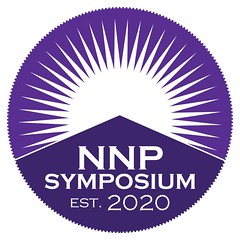 Featuring 18 presentations, the 2025 Newman Portal Symposium was held April 24-26 in conjunction with the Central State Numismatic Society convention in Schaumburg, IL. Video of this event is now available on the Newman Numismatic Portal YouTube channel. Speakers covered a variety of ancient, world, and modern numismatic topics.
Featuring 18 presentations, the 2025 Newman Portal Symposium was held April 24-26 in conjunction with the Central State Numismatic Society convention in Schaumburg, IL. Video of this event is now available on the Newman Numismatic Portal YouTube channel. Speakers covered a variety of ancient, world, and modern numismatic topics.
A highlight of this year's Symposium was Jeff Garrett's talk on the Great Kentucky Hoard, a recent find of 800 U.S. gold coins from the Civil War-era, unearthed on a Kentucky farm. The presentation included video of the coins in situ, prior to excavation. This a tribute to the finder, who understood the import of the event from the very moment of discovery. We would not have been so patient!
Link to 2025 Newman Portal Symposium on YouTube:
https://www.youtube.com/playlist?list=PLDk2lseZ-iyrI7iLAQgarglNgxPgtRBLT
Here are descriptions of some of the talks. -Editor
Counterfeit Ichibu Silver Coins from Japan By Ben Dalgleish
Silver ichibu are rectangular coins minted from 1837 to 1869 in pre-Meiji Japan. While popular for their distinctive shape and low price, they've also been widely counterfeited over the years. Join Ben Dalgleish to learn how to separate genuine from counterfeit examples.
The Gerome Walton Collection of Nebraska National Bank Notes and its Digital Preservation
By Matt Hansen
This presentation will showcase the remarkable Nebraska national bank note collection assembled by Gerome Walton between 1965 and 2021, and how that collection was digitally preserved for current and future study before being dispersed for sale.
A Numismatic Memento of a Life-Long Love
By Bob Bair
Learn how "Love Tokens" and a "family heirloom" "love coin" have shown a widespread expression of human love and commitment down through the ages. The article this presentation will be based on was the Fourth Place Winner out of 120+ entrants in the CACG Essay Contest held in May 2023, and has been accepted for publication in The Centinel (Spring, 2024).
Early North American Indian Peace Medals
By Christopher McDowell
This talk will examine and illustrate North American Indian Peace Meals through the reign of George III. McDowell will discuss what an Indian Peace Medal is, their use, who, where, and why they were issued, and their historical and cultural significance.
Major Mint Errors: How Are They Made?
By Greg Bennick
Take a look at some truly incredible mint errors, a few minor ones, along with an in-depth explanation of how they were made. Greg Bennick is a passionate error collector who will help you understand more about these incredibly cool coins and will invite you to explore this fascinating area of numismatics.
Podcasts and Digital Info for the Numismatic Enthusiast: Researching Coins in the Misinformation Era
By Mike Nottelmann
Long-time host of The Coin Show Podcast Mike Nottelmann will discuss the current landscape of numismatic podcasts and media, with recommendations for all levels of collector. With abundant clickbait articles, videos, and social media posts clogging media sites, he'll provide tips and guidelines for ensuring your numismatic media is trustworthy.
To read the earlier E-Sylum articles on the Great Kentucky Hoard, see:
THE GREAT KENTUCKY HOARD
(https://www.coinbooks.org/v26/esylum_v26n25a18.html)
MORE ON THE GREAT KENTUCKY HOARD
(https://www.coinbooks.org/v26/esylum_v26n29a20.html)
THE GREAT KENTUCKY DRAMATIZATION
(https://www.coinbooks.org/v27/esylum_v27n20a12.html)
VIDEO: GETTING KIDS INVOLVED IN COIN COLLECTING
The David Lisot Video Library on the Newman Numismatic Portal can be found at:
https://nnp.wustl.edu/library/multimediadetail/522852
We highlight one of his videos each week in The E-Sylum. Here's one from 2009 with young collectors (who aren't so young anymore) talking about enticing new collectors. -Editor
Katie Heinrich, Cole Schenewerk, & Jeff Swindling The future of the coin collecting hobby depends upon new collectors being created. Who better to share ways to get kids involved than other young people who collect coins. These three young people exemplify exactly what the hobby needs to stay strong.
Speaker(s): Katie Heinrich, Cole Schenewerk, Jeff Swindling.
To watch the complete video, see:
Getting Kids Involved in Coin Collecting
(https://youtu.be/aEm3cOLW_-g)
Getting Kids Involved in Coin Collecting
(https://nnp.wustl.edu/library/book/557329)
ANS AMERICA 250 MEDAL PROJECT DONATIONS SOUGHT
The American Numismatic Society is organizing a project to select and commission a medal commemorating the U.S. Semiquincentennial. -Editor
Help the ANS commemorate the American Semiquincentennial with a Medal!
The ANS is gearing up to issue a medal to commemorate the American Semiquincentennial. The ANS is trying to raise funds via a GoFundMe at https://gofund.me/fddfd532 to help defray the fixed costs of getting the project off the ground. Any donation, large or small is welcome. The goal is to issue a beautiful, high quality, relatively low mintage, struck medal that is not prohibitively expensive. The only way to do that is to seek support from donations.
Even if you can't donate yourself, please consider sharing the appeal with your numismatically or historically inclined friends. Small donations from a lot of people can add up and make all the difference!
As the ANS is a 501(c)(3) organization, all contributions are fully tax-deductible.
Here's the background from the effort's GoFundMe page. Please consider a donation - this is a quality effort to commemorate an important milestone. Images are of earlier ANS medals. -Editor
 In 2026, the United States of America will celebrate the 250th Anniversary of its independence. This momentous occasion deserves to be commemorated in style!
In 2026, the United States of America will celebrate the 250th Anniversary of its independence. This momentous occasion deserves to be commemorated in style!
The American Numismatic Society (ANS) is one of the Nation's oldest cultural institutions. The ANS is a 501(c)(3) organization that was established in 1858 to appreciate and educate the public about coins and medals.
The Society issued its first medal in 1866 to commemorate the nation's assassinated President, Abraham Lincoln. Since then, the ANS has issued around sixty medals, usually in small editions, but always designed by artists who were among the very best sculptors of their day. The ANS medals have ever been a class apart from the mass-produced wares designed for commerce by committee or focus group.
The ANS wants to continue this proud tradition by issuing a beautiful medal to celebrate the American Semiquincentennial, which is what numismatists call a 250th anniversary. As in the past, the medal will be of the highest artistic value and struck in a relatively small mintage.
But the 21st century is very different from the 19th and 20th centuries:
- Many art schools do not teach bas-relief sculpture anymore because other forms of artistic expression are more marketable today.
- Most organizations cannot afford to or do not want to pay the hefty price for a quality design and the production of dies used to strike the medals.
- Many mints that used to produce high-quality art medals have gone out of business, taking their institutional knowledge with them.
The challenges are therefore clear:
- To end up with a great medallic design, the ANS has to commission designs from several artists. Whether their designs are selected or not, these artists deserve to be paid for their efforts.
- Whether we strike one medal or 10,000, the production cost of the dies from which the medals are struck is the same.
- The cost of striking high-relief medals will be higher as we resurrect this nearly lost art.
 We need your help to get this project off the ground! Our goal is to create a beautiful, classic art medal to commemorate our nation's anniversary. We believe this is possible, but we cannot do it alone. The ANS is asking you to help us bear the expense of this audacious project.
We need your help to get this project off the ground! Our goal is to create a beautiful, classic art medal to commemorate our nation's anniversary. We believe this is possible, but we cannot do it alone. The ANS is asking you to help us bear the expense of this audacious project.
Our goal is to raise $40,000 by September 2025. The raised funds will help defray the fixed costs of:
- Commissioning designs from several artists.
- Producing dies in two different sizes.
- Marketing and managing project overhead.
This will help us keep the per-medal costs low, making them more affordable for everyone.
As the ANS is a 501(c)(3) organization, every dollar you donate is tax-deductible.
For more information, or to donate, see:
Help ANS Honor America's 250th Anniversary
(https://www.gofundme.com/f/help-ans-honor-americas-250th-anniversary)
MAY 2025 PAN SHOW EVENTS
The Pennsylvania Association of Numismatists runs the largest national show in the northeast, getting bigger and better nearly every year. Now it's busting out to take over the entire Monroeville Convention Center just outside Pittsburgh. Pat McBride (also known as Dr. Benjamin Franklin) is PAN's President, and he shared these thoughts in his President's Message in the Spring 2025 issue of the club publication The Clarion. -Editor
 I am very excited about our expansion into the South Hall starting with the Spring
PAN Coin Show occurring May 29–31, 2025. Our plan is to greatly expand our Competitive Exhibits space. The exhibit committee wants to attract more participants from all
areas of the country. We are no longer confined by the number of cases or multiple exhibits anymore. This is a major growth opportunity for us.
I am very excited about our expansion into the South Hall starting with the Spring
PAN Coin Show occurring May 29–31, 2025. Our plan is to greatly expand our Competitive Exhibits space. The exhibit committee wants to attract more participants from all
areas of the country. We are no longer confined by the number of cases or multiple exhibits anymore. This is a major growth opportunity for us.
The expansion will provide more space for our previously overcrowded PANKidZone. Our Young Numismatist Committee is working on more interactive activities since there will now be plenty of space. Numismatic Imagination will now become a reality with the new space. I am anxious to see what new features are offered for our young and growing coin enthusiasts.
The South Hall will also feature a special display, "Artifacts and Coins of the S.S. Central America, Ship of Gold." Chief Scientist and Historian Bob Evans and display creator Greg Darnstaedt will be present to take you on this incredible shipwreck find!
The PAN Living American History will also be housed in the new space. We will be able to present historical lectures with backdrops, props, and seating at each set design. This Spring Show will feature a beautiful presentation titled "George and Martha Washington, A Love Story" featuring our own General Washington played by Curt Radabaugh and seasoned actress Alisa Dupuy playing Martha Washington. This step back in time is a must-see and will be presented each day during our Spring Coin Show. Abraham Lincoln will give his Gettysburg Address from his War Room backdrop (the modern-day Lincoln Bedroom in today's White House). Dennis Boggs presents one of the most moving and compelling versions of this short famous speech.
Our Spring Coin Show bourse floor is close to being sold out with a wide variety of coin dealers from across our country featuring U.S. coins, paper money, foreign coins and currency, historical medals, related ephemera and more!
The Friday Richard C. Jewell Lecture Series sponsored by Stacks Bowers Galleries has a fine lineup of speakers.
A personal note: my health continues to improve through my leukemia battle. I will be at the coin show!
Here are some of the educational events on the show's schedule. -Editor
Thursday, May 29
6:30pm - PAN Spring Banquet, LeMont Restaurant. Live Music, PAN's Living American History - Benjamin Franklin (Patrick McBride), George Washington (Curt Radabaugh) & Abraham Lincoln (Dennis Boggs) will offer a few words.
Friday, May 30
PAN Lecture Series Area – South Hall
12:00pm – Greg MaGee, Ancient Dealer, Cybercoins.net
Topic: "Ancient Coins of Alexander the Great"
1:00pm – Jeff Garrett, from Mid-American Rare Coin Galleries
Topic: "The Great Kentucky Hoard of U.S. Gold"
2:00pm – Vic Agha, from Stack's Bowers Galleries, Philadelphia
Topic: "The Nickel Standard"
3:00pm – Greg Darnstaedt & Bob Evans, chief historian SS Central America
Topic: "Coins and Artefactsn from the SS Central America, Ship of Gold"
4:00pm – Curt Radabaugh & Alisa Dupuy, reenactors
Topic: "George and Martha Washington, A Love Story"
Saturday, May 31
Lecture / PANKidZone Area
1:00pm – Curt Radabaugh & Alisa Dupuy, reenactors
Topic: "George and Martha Washington, A Love Story"
2:00pm - Robert O. Stakeley, Heinz History Center, Educational Director
PANKidZone
Program: short talk, games, prizes, Kid's auction
For more information on PAN and the show, see:
https://pancoins.org/
THE CROWNED F 'FOREIGNER'S MARK'
Julia Casey submitted these notes on the "Crowned F" counterstamp. Thank you! -Editor
 Regarding the 'crowned F' counterstamps from the April 27th E-Sylum. A mark that seems possibly to be related to the stamp on the halfpenny was used on guns made in England. It is a "Foreigner's Mark" and Google A.I. gave me these details below. I hunted around and found a few images from 18th century gun auctions. I don't know if the stamp on the shilling could be part of this same category. Like you said, it does look a little different.
Regarding the 'crowned F' counterstamps from the April 27th E-Sylum. A mark that seems possibly to be related to the stamp on the halfpenny was used on guns made in England. It is a "Foreigner's Mark" and Google A.I. gave me these details below. I hunted around and found a few images from 18th century gun auctions. I don't know if the stamp on the shilling could be part of this same category. Like you said, it does look a little different.
A gun's "foreigner's mark" is a stamp or symbol placed on a firearm to indicate that the gunmaker was not a member of the London Gunmaker's Company. This mark was typically a small "F" or "F" under a crown, signifying that the gunmaker wasn't part of the official guild.
Elaboration:
London Gunmaker's Company:
In the 18th and 19th centuries, the London Gunmaker's Company was a prestigious organization that regulated the production and quality of firearms in London.
 Foreigner's Mark:
Foreigner's Mark:
If a gunmaker wasn't a member of this company (and therefore wasn't subject to their rigorous standards), a "foreigner's mark" was placed on their firearms to indicate this.
Example:
On the Met's pair of flintlock pistols, the foreigner's mark is an "F" beneath a crown, along with other markings like the gunmaker's initials and the London proof marks, according to the Metropolitan Museum of Art.
Significance:
This mark served as a way to distinguish the work of non-members of the London Gunmaker's Company, potentially affecting the perceived quality and value of the firearm.
I found this Worthpoint listing for another halfpenny and the seller had some thoughts that coincide. They also gave it a Brunk number.
Brunk-F-3 Crowned F Counter stamp 1749 English Farthing. Brunk does list this under English C/S pieces as Crowned F and this one is similar while on a different host coin. I think a Proof mark from a gunsmith or arms company.
To read the complete lot description, see:
Brunk-F-3 Crowned F Counter stamp 1749 English Farthing
(https://www.worthpoint.com/worthopedia/brunk-3-crowned-counter-stamp-1749-1926991143)
To read the Brunk listing on the Newman Numismatic Portal, see:
Merchant and Privately Countermarked Coins
(https://archive.org/details/2006merchantandprivatgregbrunk/page/44/mode/1up)
To read the earlier E-Sylum article, see:
NOTES FROM E-SYLUM READERS: APRIL 27, 2025 : A Counterstamped 1787 British Shilling
(https://www.coinbooks.org/v28/esylum_v28n17a10.html)
NOTES FROM E-SYLUM READERS: MAY 11, 2025
More on 1733 Rosa Americana Twopence Copies
 Saul Teichman writes:
Saul Teichman writes:
"I saw the article on the 1733 Rosa Americana twopence copies. With regard to the original, it is noted that five are known but I can only trace four: British Museum, Garrett, Boyd-Ford and Norweb-Ford. The Smithsonian, which is often mentioned as having one, does not. It has several copies."
Thank you! -Editor
To read the earlier E-Sylum article, see:
ROSA AMERICANA 1733 TWOPENCE IMAGES AND COPIES
(https://www.coinbooks.org/v28/esylum_v28n18a09.html)
More on the 1838-O Half Dollar
 Regarding 1838-O Half Dollars, Julian Leidman writes:
Regarding 1838-O Half Dollars, Julian Leidman writes:
"I owned two at the same time in 1975; not that easy to sell."
Nancy Oliver and Richard Kelly write:
"We liked the interesting story in the latest E-Sylum on the 1838-O half dollar, but couldn't help providing a bit more. We would like to add a little tidbit to said story of the striking of said coin.
"In our January 2015 "Numismatic Chronicles" column in the ANA's monthly, The Numismatist, we discussed this issue at length, and had a discovery.
 "We learned from a contemporary newspaper that it was announced by a former Superintendent of this New Orleans Branch Mint that the great granddaughter, Francis Parke Lewis Butler, of former U. S. President George Washington received a piece of this extreme rarity while with her husband at the mint. Her husband, West Point graduate Colonel Edward George Washington Butler, it was said, that he was maybe with her when the coins were struck.
"We learned from a contemporary newspaper that it was announced by a former Superintendent of this New Orleans Branch Mint that the great granddaughter, Francis Parke Lewis Butler, of former U. S. President George Washington received a piece of this extreme rarity while with her husband at the mint. Her husband, West Point graduate Colonel Edward George Washington Butler, it was said, that he was maybe with her when the coins were struck.
"Of course, we have no proof of this, but several newspapers printed this story of her possession.
"Anyway, truthful or not, it made for an interesting possibility.
"If readers are interested, we go into a full story of this issue, and the genealogy of the couple in our column of that date above. We also have a theory on where the piece might have ended up."
Thanks, everyone! -Editor
To read the earlier E-Sylum article, see:
NOTES FROM E-SYLUM READERS: MAY 4, 2025 : The Stolen duPont 1838-O Half Dollar
(https://www.coinbooks.org/v28/esylum_v28n18a08.html)
Connecting the Arthur Sargent Dots
Pete Smith writes:
 "Last week Marc Ricard provided a biographical profile of Arthur Hewes Sargent (1856-1932).
This began with the statement, "A longtime 19th and early 20th century collector."
"Last week Marc Ricard provided a biographical profile of Arthur Hewes Sargent (1856-1932).
This began with the statement, "A longtime 19th and early 20th century collector."
I researched this Sargent the previous week and found no reference to his being a coin collector or consigning to the Chapman sale. I believe that is the same problem Mark Borckardt had. The name fits but there is no proof.
I would like to know what proof, if any, was found."
A name match is a great clue, but not in itself proof. It's a big world and name matches are a lot more common than one would suspect. S.H. Chapman listed the consignor as "Arthur Sargent, Esq." with no middle name. Researchers look at multiple attributes to confirm a match - date and place of birth for the subject and their family members, occupation, places lived, etc. In this case Pete is looking for confirmation that the subject ("suspect"?) was indeed a collector. This is often confirmed by the membership in coin clubs, articles published, diaries, mentions by other collectors, etc. Does anyone have more information? -Editor
To read the earlier E-Sylum article, see:
ARTHUR HEWES SARGENT (1856-1932)
(https://www.coinbooks.org/v28/esylum_v28n18a07.html)
On the Norco Vodka Encased Half Dime
Paul Hybert writes:
"I have no facts about the "Norco Vodka Encased Half Dime" but here are my thoughts/impressions:
"It might date to the US troops in eastern Russia at the end of World War I, at Vladivostok and along the railroad. Only the value of 25 kopecks is in Russian, with all other words in English. "FOR GRIPE SAKE" might be a soldier's lament of "For gripe's sake." Maybe an attempt to familiarize the locals with the value of coins carried by US soldiers.
"Using a pre-war 60-cent value for one Russian ruble, 25 kopecks would be worth 15 cents. The silver US 5-cent coin, plus maybe some value from the Chinese copper coin, might be worth 25 kopecks due to Russian inflation during their civil war."
Eric Schena writes:
"That is a really interesting piece. It appears to be pre-1917 because of the older form of the E character in the fourth position (looks like a lowercase b with a line through it). Very weird that it is a half dime set inside another coin as the encasement. GRIPE SAKE I think is not a product or similar, but an expression, like an older form of "for cripe's sake".
"As for Russo-Chinese trade, it would not be out of place to find some sort of multinational ad token on the eastern portion of Russia and China. Harbin and Vladivostok were close-ish and there was a lot of trade. In the 1920s and 1930s the USSR fought several battles with the Chinese and Japanese over control of railroads and trade routes. I have seen some multilingual paper money in Chinese, Russian, and English, so not too surprised by that nature of the piece. I do think that the supposition that it's a turn of the 20th century ad piece is probably close to the truth.
"The other thing is that it could be from Norco, California in Riverside Co. It's definitely not unheard of for Chinese coins of all sorts to make their way to California at the turn of the 20th century, so maybe that has some sort of connection."
Interesting ideas - thanks, everyone. -Editor
To read the earlier E-Sylum article, see:
NOTES FROM E-SYLUM READERS: APRIL 27, 202 : Norco Vodka Encased Half Dime
(https://www.coinbooks.org/v28/esylum_v28n17a10.html)
Coin Analysis
Thomas Lovelace writes:
"Last month I went to my local library to see if they had a copy of Chinese Cash Coins by David Hartill, doubting that they would. They didn't, but the librarian told me about a program in California where the libraries will buy books that they don't have available and have them sent directly to an individual who brings them to the library when they are done with them. Within a few days I had the book. I still have the book and my problem is that I think it is so good that I don't want to turn it in, but I eventually will and buy my own copy. Others may want to look into similar programs at their local libraries.
"Being the kind of guy who buys the coin before the book, I analyze coins scientifically more than I find in published data. For example, I weighed each of about 100 wu zhu coins to find the weight distribution. Wu (5) zhu is supposed to be the weight of 500 grains of millet (4 grams). In the photo, the top row is 5.0x and 5.3x grams. The second row is 4.0x to 4.5x grams. The third row 3.0x to 3.9x grams. The 4th row is 2.4x and 2.7x to 2.9x grams. The bottom one is 1.84g. There is a lot of variability in the dies of each coin and no 2 are identical. Sort of to be expected for coins that were made for hundreds of years. These days, potentially a lot could be unauthorized or recent copies.
"This group is all probably authorized and a representative sample because they were obtained at various times and places during the 20th century for a few cents each and not recently when a lot more fakes are being made. About half are 5 zhu (4 grams) +/- 10%. Close to half are 4 zhu (3.2 grams) +/- 10%. A few are outside these ranges. This would seem to indicate that over time these coins became debased like almost all other coins that circulated for a long time. The outliers are probably unintentional mistakes as opposed to efforts to deceive. One coin of this group is magnetic to a refrigerator magnet, but not as magnetic as an iron coin would be. It is likely a copper coin with iron impurities in the 2-3% range. The rest of the coins are non magnetic.
"Other examples of my analyses of statistically large samples of coins are that 8% of 1945-S Mercury dimes are the micro S variety. 92% are either the medium S or large S varieties. In the 1941 Mercury dimes, the S mint mark size was changed and there are small and large mint marks. Only 2% are the large S variety and 98% are the small S variety. This analysis was done decades ago when 10,000 dime bags still contained large numbers of Mercury dimes. The bags came from various sources, so I consider this data representative."
Lots of numismatic fun! -Editor
 1860 Token Pictures African-American Fishing
1860 Token Pictures African-American Fishing
John Linhoss writes:
"The Miller 1008 NY token minted in 1860, in my finding, has an African American fishing. I believe this token has never been described with this being forefront. I believe this has a powerful message for the time. There are so many details overlooked in various tokens / coins hobbyists have yet to discover. This being one until now."
I think you're right - interesting find. -Editor
CASTORLAND SCAVENGER HUNT ANNOUNCED
Chester Sullivan is a longtime researcher of the Castorland Jetons, a fascinating episode in early American history. To encourage collectors to report examples new to his census he's offering a monetary award. -Editor
Castorland was long assumed to have been a small colony of French refugees but in fact Castorland was a 2,000 acre land speculation directed by the well-connected French banker, Pierre Chassanis. To add glamour to his enterprise Chassanis arranged for jetons to be minted and their relevance to American history made them sought by collectors. The coins were struck in small batches from 1796 into the mid-eighteen hundreds. To build a firm basis for their study I assembled descriptions of specimens into a Census of Original-Dies Castorland Jetons with the first specimen in the list identified as AA, the next one AB, etc. The Census ID's proceed alphabetically and the most recently added specimen is DO. So the Census now has 93 fully described specimens.
To stimulate interest in searching out even more specimens I'm inviting researchers to accompany me on a scavenger hunt. Researchers who describe new specimens for the Census will be honored (and enriched) by the handsome Jefferson Monetary Award for Excellence in Numismatic Research certificate. An easy to follow guide, How to Identify Original-Dies Castorland Jetons, can be viewed on the NNP. It includes a listing by Type of all specimens currently in the Census. And the money reward is real, but winners have to find it.
Why is the Award named Jefferson? Because Thomas Jefferson when Secretary of State was approached by Chassanis' agent, Simon Desjardins. Jefferson wanted no part in Chassanis' enterprise, which he saw destined to fail and he gave Desjardins a cool reception, but such was not the case with Gouverneur Morris, Jefferson's fellow signatory to the United States Constitution. Morris served as an agent of La Compagnie de New York during its demise.
To read How to Identify the Seven Types of Original-Dies Castorland Jetons on Newman Portal, see:
https://nnp.wustl.edu/library/booksbyauthor/556055
To read the earlier E-Sylum article, see:
HOW TO IDENTIFY CASTORLAND JETONS
(https://www.coinbooks.org/v28/esylum_v28n17a08.html)
A 100 GREATEST U.S. COINS COLLECTION
Numismatic books have always led the way for the numismatic hobby. The publication of a new catalog often ignites interest in a sleepy or overlooked series. The coins were always there, but the book now provides a guide for collectors.
A Greysheet article from Great Collections Coin and Currency Auctions describes the slow reveal of a collection based on the 100 Greatest U.S. Coins book by Jeff Garrett. These coins have always been sought by collectors, but the book provides a new way of organizing a collection. -Editor
Over the past few weeks, coin collectors have been enjoying one of the greatest reveals in numismatics, with a user on numismatic social media platform MyCollect posting daily updates of the rare coin collection he has assembled over the past five years.
This is not just any collection or set - it is based on the 100 Greatest U.S. Coins book by Jeff Garrett. While the collector has not posted the number of coins in his collection yet, MyCollect members are already speculating whether it will surpass that of famed past collectors such as Louis Eliasberg and Amon Carter, and even current collector D.L. Hansen, who has an impressive 69 coins from the 100 coins listed in the publication.
 The book by well-known numismatist Jeff Garrett ranks the most important coins issued by the U.S. Mint since its founding in 1792, showcasing the most significant and storied coins, blending historical context, rarity and collector appeal. Aside from famous coins such as the 1909-S VDB Lincoln Cent and 1916-D Mercury Dime, the book also features trophy coins that are unique or semi-unique, including the 1861 Liberty Gold Paquet Reverse Double Eagle and 1933 Saint-Gaudens Gold Double Eagle.
The book by well-known numismatist Jeff Garrett ranks the most important coins issued by the U.S. Mint since its founding in 1792, showcasing the most significant and storied coins, blending historical context, rarity and collector appeal. Aside from famous coins such as the 1909-S VDB Lincoln Cent and 1916-D Mercury Dime, the book also features trophy coins that are unique or semi-unique, including the 1861 Liberty Gold Paquet Reverse Double Eagle and 1933 Saint-Gaudens Gold Double Eagle.
"For many collectors who embark upon a collection, they acquire the more common coins first, leaving the rarities until last. Elite did the exact opposite as the initial coin added to his set was the 1933 Saint-Gaudens Gold Double Eagle. The second coin acquired was a superb example of the 1870-S Silver Dollar, one of only a dozen coins that are known today in all grades. And the list goes on. Some of the coins have not been seen in decades," said Ian Russell, president of GreatCollections who assisted the owner in forming the Elite Collection.
"Another difference with a collection of this calibre, both in rarity and accessibility is Elite's willingness and encouragement to display these famous coins at major shows around the country, so collectors can enjoy them. We look forward to displaying the unique 1844-O $5 and $10 Proof gold coins at the upcoming ANA World's Fair of Money in Oklahoma and other rarities at additional shows in 2025 and 2026," added Russell.
Kudos to the collector for displaying the coins for the public to view. This is another longstanding tradition in the numismatic world. I'll look forward to seeing the ANA display. -Editor
To read the complete article, see:
Collection of 100 Greatest U.S. Coins Surprises Industry
(https://www.greysheet.com/news/story/collection-of-100-greatest-us-coins-surprises-industry)
To read the earlier E-Sylum article, see:
NEW BOOK: 100 GREATEST U.S. COINS, 6TH ED.
(https://www.coinbooks.org/v27/esylum_v27n48a03.html)
For more information, or to order the book, see:
100 Greatest United States Coins , 6th edition (6x9)
(https://whitman.com/100-greatest-united-states-coins-6th-edition-6x9/)
VOCABULARY TERM: RESTRIKE
Here's another entry from Dick Johnson's Encyclopedia of Coin and Medal Terminology. -Editor
Restrike. A numismatic item struck from original dies but at a later time than the original issue – coins struck in a year later than the date they bear, medals struck after an interval of time and regular issuing has ceased. Restrikes are often by dies in deteriorated state, usually (but not always) the restriking is unauthorized and mostly surreptitious.
A restrike denotes the use of at least one original die; if a replacement or copy die is used (of the exact same designs but not made from the original hub or model) it is termed a novedel. The term restrike is not to be confused with reissue (which implies a proper authorization for use of the old dies) nor with revision (which implies the use of new copy dies or reworked old dies).
Restriking from old dies present several problems: rusting in the dies if improperly stored (dies will pit irregularly) and brittleness of the dies (may cause cracking, breaking or shattering of a die). Also old dies may exhibit a degree of sinking. Pressmen must exercise great care during setup and striking to prevent breaking old dies. See copies and replicas.
The Paris Mint has restruck old dies for a series it calls "original dies" through their Le Club Francais de Medaille. Dies as early as mid 1600s have been struck side-by-side in soft tin rectangular plates. Each piece is serially numbered in a series limited to 300 such strikes. The soft tin is capable of obtaining an impression from the old and brittle dies, however, the tin is not a medium for creating permanent specimens. The tin is so soft a fingernail will dent it deeply; extreme care must be exercised in handling these pieces as anything heavier than a paper clip dropped on them – or dropping the item itself – will damage it extensively.
The French word for restrike is refrappe.
To read the complete entry on the Newman Numismatic Portal, see:
Restrike
(https://nnp.wustl.edu/library/dictionarydetail/516637)
WILLIAM HESSLEIN (1868-1932)
E-Sylum Feature Writer and American Numismatic Biographies author Pete Smith submitted this article on dealer William Hesslein. Thank you! -Editor
 A profile of William Hesslein was in The E-Sylum five years ago on May 3, 2020. This article
will expand somewhat on what was mentioned then. Public records for William Hesslein have
gaps and inconsistencies. My emphasis is on his residence and his family more than on his
numismatic business. This is my best guess on the facts.
A profile of William Hesslein was in The E-Sylum five years ago on May 3, 2020. This article
will expand somewhat on what was mentioned then. Public records for William Hesslein have
gaps and inconsistencies. My emphasis is on his residence and his family more than on his
numismatic business. This is my best guess on the facts.
William Hesslein was born in Manhattan on June 27, 1868. His parents were Samuel A. Hesslein (1831-1904) and Rosalie De jong Hesslein (1845-1916). Their children included Edgar Joseph Hesslein (1865-1938), William (1868-1932). Gertrude Hesslein Bloch (1871-1956), Ida Hesslein Hirsch (1875-1951), Estelle Hesslein (1879-1931) and Arthur Maurice Hesslein (1885-1921). The 1868 birth record does not include the first name but it must be William based on birth years for his siblings.
The 1880 Census has the family indexed as Hessler but shows ages as Samuel 48, Rosalie 34, Edgar 15, William 12, Gertrude 9, Ida 5 and Estelle 6 months.
William Hessslein married Clara M. Howard on April 28, 1891, in Jersey City, New Jersey. Clara was granted a divorce on April 5, 1894. She charged her husband with improper conduct with another woman at the Manhattan Hotel in October 1893. She probably had other legitimate reasons.
William Hesslein married Stella Cecilia Stickney on December 8, 1895, in Jersey City, New Jersey.
The 1900 Census shows William Hesslein, born in June 1865. He is living at 878 Elm Street in New Haven, Connecticut, with Stella, age 32, Helen (1893-1981), age 7 and Jorden (1893-1961), age 7. William is listed as a travelling salesman.
The 1900 Census is unreliable. It gives an incorrect year of birth for William and the twins. It lists the son, George Irwin Hesslein as Jorden. It gives their place of birth as Ohio rather than Chicago. The Census reports that William and Stella had been married for nine years rather than five. This would have given legitimacy to their children. If Stella was the mother of the twins, they were born before William was divorced from Clara.
In March 1905 Hesslein advertised in The Numismatist from P. O. Box 879 in New Haven, Connecticut. His application for membership in the ANA was published in November 1905. He was listed as new member #786 in December 1905.
In the November 1906 issue of The Numismatist, Hesslein offered $2½ gold pieces at auction closing January 15, 1907. This was his first reported auction.
In 1906 Hesslein advertised from 674 Elm Street in New Haven, Connecticut.
In 1909, Hesslein offered a fixed price list. Also in 1909, he was admitted to the New York Numismatic Club.
The 1910 Census has William Hesslein, age 41, and Stella, age 41, living with another couple and a servant at 674 Elm Street in New Haven. They had been married for 18 years. His profession is Numismatist.
In 1912, he relocated his office from home to the Malley Building in New Haven. In May 1913, he relocated to the Paddock Building on Tremont Street in Boston. In February 1917, he changed his business address to 101 Tremont Street in Boston.
With the move to Boston, Hesslein began to run classified ads in the Boston Globe on February 3, 1916. These ran several times a week until December 12, 1919.
Hesslein advertised extensively with small ads in general circulation magazines like Popular Mechanics and Popular Science. He offered his prices paid list for 10 cents.
Between Hesslein's third auction sale in 1910 and his 108th sale in 1924, there are only ten confirmed sales. That puts his number of sales at just fifty.
In 1920. Helen Hesslein, age 26, was a boarder in New Haven. George Hesslein. Age 26. was living with his wife, Eva, in New Haven. William and Stella have not been found in the 1920 Census.
John W. Adams had comments about Hesslein catalogs in the October 2013 issue of Penny-Wise:
"Why would anyone collect a cataloguer whose output is ill-mapped, where the content is minimal, with the series lacking any special features and, given their extreme scarcity stemming from the mediocrity of the material at the time of issue."
Hesslein's ad in the May 1929 issue of The Numismatist included this statement: "I claim to be the best-known coin dealer in the United States." I believe that statement to be true. He did make that claim.
The 1930 Census has Stella, age 61, and Helen, age 36. Living in Waltham. Massachusetts. William was probably living in Boston but not with his wife and not found in the Census.
The 1940 Census had Stella Hesslein, age 72, living with George Hesslein, age 47, and Helen Hesslein, age 47.
William Hesslein conducted his last auction sale, number 144, on December 4, 1931. He ran ads in the December 1931 and January 1932 issues of The Numismatist promoting his next sale. Presumably he continued to take consignments for that next sale. But then he disappeared, probably around January of 1932.
In February 1932, his ad was still running in Popular Science magazine. On February 29, 1932, an auction was conducted and the assets of the company were sold to the mortgage holder for $600. It is likely that some creditors remained unpaid.
In 1932, J. F. Le Blanc with Associated Coin and Stamp Co. advertised as successors to Hesslein at 101 Tremont Street in Boston.
Hesslein's reported disappearance was not mentioned in numismatic literature or local newspapers at the time.
Thomas Elder commented on Hesslein in a 1939 issue of Hobbies Magazine:
"Mysterious Death of William Hesslein
Some thirty to thirty-five years ago William Hesslein, once of New Haven, Conn., later of
Boston, Mass., handled a great many coins. Mr. Hesslein was for a time a sort of travelling
salesman who sold druggist's sundries, if I recall correctly. He travelled all over the eastern part
of the United States and seemed to do quite a business in his line. With these he handled coins,
which he carried from city to city in a grip-sack and many fine coins came his way.
Presently came rumors of financial troubles of some sort when suddenly Mr. Hesslein disappeared from public view and to my knowledge has never been seen or heard of again, not by his own family even. This was some ten years ago or over. Simply he disappeared as suddenly as a meteor, whether by suicide or otherwise no one, not even his family ever learned."
Ray Williamson wrote a letter that was published in the June 1985 issue of Rare Coin Review:
"In the late 1930's or early 1940's, I heard fourth-hand gossip that Hesslein had acquired a batch of high-priced gold coins on consignment for an auction, and had then decamped with his secretary – and the gold coins."
I suspect that the rumors are an embellishment based on scant facts. I can believe Hesslein may have failed to pay a consignor. I really doubt that Hesslein, at 84 years old, decamped with his secretary.
My best guess, based on my recent research, is that he was a suicide around January 1932.
A search for William Hesslein in the Newman Numismatic Portal yields 311 hits. A search for William G. Hesslein yields just twelve. I am not aware of any contemporary source that gives his middle initial. There was a William G. Hesslein (1875-1955) who was a farmer in Illinois.
To read the earlier E-Sylum article, see:
WILLIAM G. HESSLEIN (1866?-1932?)
(https://www.coinbooks.org/v23/esylum_v23n18a25.html)
TREASURE TALK WITH BOB EVANS, EPISODE 4.2
In January, our good friend Bob Evans began publishing a series of blog articles on the Finest Known website detailing his experience as co-discoverer and curator of the treasures recovered from the wreck of the S.S. Central America. Subject of the book "Ship of Gold", many exhibits, countless interviews and articles, books and auction catalogs feature the legendary haul of gold coins, bars, nuggets, gold dust and more from the 1857 shipwreck. Here's another excerpt - see the complete article online. -Editor
We were granted a 90% salvage award, but it dragged on, for a few more years. They appealed. It was upheld on appeal. Finally, re-opening an unresolved matter, we appealed, contending that two of the insurance entities had not proven they were connected with this treasure in any way. So, those entities were removed from the list of claimant underwriters, and the Underwriters percentage was reduced slightly, and ours increased reciprocally. This is how we arrive at the final figures often reported in the press, 92.4% for us, or "seven and a half percent" for the Underwriters.
Legal actions and troubles hung over the gold almost from the moment we found it and throughout the 90s. Meanwhile, most of the treasure sat in relative obscurity at Brinks, still covered with rust and minerals, its true condition, grade, and many of its secrets still unknown, waiting to be discovered.During the 90s I arranged to transport to my lab, and curate, a few hundred coins and a few dozen bars. But there were over 7,000 gold coins and more than 500 gold ingots. Ever since our discovery, I had subscribed to various numismatic publications. So, I read the frustrations that were expressed. Everyone wanted to know everything about the treasure. Me too. These matters could not be fully resolved until the legal issues were all settled. We needed to establish who owned what portion of the pie before we could see if it was apple or cherry or rhubarb.
Thompson could not reach an agreement with the Underwriters for a unified marketing and monetization. For our part, during the 90s we spent a lot of resources examining grandiose marketing schemes with top consultants, people who had managed Olympic Games, displayed the Hope Diamond, and built grand opera sets. We cooperated with author Gary Kinder who wrote a non-fiction bestseller about the project, Ship of Gold – in the Deep, Blue Sea. We also had two somewhat small-splash exhibits locally in Columbus, at the Art Museum and at the Columbus Zoo, highlighting our photography and technology, and non-gold artifacts. We did not feature much gold at all. We had an arrangement of gold dust and nuggets in one case, no bars or coins.
Judge Kellam passed away in 1996, and US Federal District Judge J. Calvitt Clarke inherited the case. Because the Underwriters and Tommy continued to disagree about marketing, he ordered a "Division in Kind." The treasure was to be split physically, with each party receiving title and ownership to its own portion.
The subject is longer than I wish to address here. I will eventually write a whole chapter for the math nerds. But we agreed that I would divide the treasure into 90 parts. The Underwriters were to receive seven of the 90 parts. The idea was that the Underwriters would select first, then us, then them, then us, etc., alternating until they had their 7/90 of the treasure.
To provide expertise for the Underwriters, the Court had previously appointed Fred Holabird to examine the treasure and advise them. At our first meeting at Brinks in 1997, we danced around each other with various declarative statements for about ten minutes. Fred figured out that I was real (who knows what their attorneys had told him,) and that I had properly handled and catalogued everything. I found out that we were fellow geologists, and he was just as genuinely interested in what we had to look at as I was. Although working for different "sides," we quickly became friends, cooperative partners in an examination that took a total of 22 days (not consecutive.) We both just wanted to find out more of the truth about the wonderful treasure. It obviously had stories to tell. Those days were great, and we thrilled together at each newly discovered detail.
Fred did a thorough, meticulous job with his examinations, and the inventory he prepared became the standard for the rest of the legal case.
So, on June 17, 1998, we assembled a courtroom of sorts, at Brinks, in their 25-yard indoor gun range. It was a cul de sac enclosure within the Brinks building. Brinks had built a new facility, really more like a fortress, in the Hampton Roads city of Chesapeake, VA. The gun range they had constructed was very secure, just one way in and out.
Prior to this, we had never taken the entire treasure out of the Brinks interior vault at one time. Thompson and our attorneys were present, the other side likewise represented, with an actual executive from the Underwriters (first time I had met one,) their attorneys of course, and their experts, including Fred Holabird. A Magistrate was present to preside for the Court.
The division went off without a hitch. The opposition and tension were all gone. It was a little like the conclusion of a playoff hockey series, with all the players lining up and shaking hands. I was disappointed when the Underwriters selected the parcel with all the native gold, the rocks. That left a little hollow in my soul. But I was happy that we were now unburdened of our reluctant "partner" in the treasure. Now they could do what they wanted with theirs, and we could do what we wanted with ours.
At long last, maybe we could finally figure out exactly what we had found. A full curatorial examination, detailed cataloguing, and conservation awaited. After the Division in Kind, Tommy Thompson abandoned the grandiose marketing plans that we had conceived, and he settled on what was probably a more practical approach. In early rounds of market research, and in one of the deals he made (with Bruce McNall,) Tommy had brought us in contact with Larry and Ira Goldberg.
The Goldbergs were my hosts during my trip to be on the Tonight Show with Johnny Carson. That original deal with McNall had gone sour, in ways that are beyond my scope here. But after we split the treasure with the Underwriters, our attorney, Rick Robol, got back in touch with the Goldbergs.
On the golf course one day shortly thereafter, Larry Goldberg mentioned that the treasure was "available" to Dwight Manley. Manley jumped at the idea of marketing the SSCA treasure. He was 32, a young, energetic dealmaker, and he was a huge California history fan and patron. Here was the chance to be involved with the greatest California Gold Rush treasure that would ever be found, the greatest lost treasure in United States history. He had to have it.
We all met in the morning in the hotel lobby, before we proceeded over to Brinks. I kept silent, watched, and listened until I was needed. We weren't too far into the exchange of opening pleasantries, when Manley asked, "So, getting down to business, these coins… are they all 1857-S double eagles?"
Tommy looked blank, just poker faced. I was actually surprised at how unfamiliar he was with the details of the treasure he had been contesting in court for almost a decade.
"Uh…" In a moment, he turned to me for answers.
I jumped in, "Well, they're not all 1857-S. There are significant numbers of 1856-S, 1855-S, as well as other mints, denominations, pioneer gold…"
Dwight sat up and gestured at me, as he turned to Larry, "This guy. He's the one who knows about the treasure." Larry nodded.
Shortly after that we drove to Brinks for the first of a few examinations that I hosted with Dwight and assorted potential marketing partners. Dwight put the pieces of a business, California Gold Market Group, together over the next year and a half. I have heard him say it was the most difficult deal he ever arranged. He needed to find the right partners. It was a huge deal, tens of millions or more. There was some legal baggage.
Christie's was suing Tommy's company for not following through with a signed contract that Thompson contended was just a "set of guidelines." I believe the auction held at Christie's on December 14, 2000, was at least partly to make this problem go away. Dwight turned it into a win-win for everyone. He got the deal done. There was a spectacular auction at Christie's, with the "Créme de la créme" of the treasure, the finest known example of every date, denomination, mint, and variety of every coin recovered until that time, as well as a splendid selection of gold bars.
To read the complete article, see:
Treasure Talk: Episode 4 Part 2
The Trials Continue
(https://finestknown.com/treasure-talk-episode-4-part-2the-trials-continue/)
For the complete series, see:
Category Archives: Treasure Talk with Bob Evans
(https://finestknown.com/treasure-talk-with-bob-evans/)
To read the earlier E-Sylum article, see:
TREASURE TALK WITH BOB EVANS, EPISODE 1
(https://www.coinbooks.org/v28/esylum_v28n12a12.html)
TREASURE TALK WITH BOB EVANS, EPISODE 2.1
(https://www.coinbooks.org/v28/esylum_v28n13a17.html)
TREASURE TALK WITH BOB EVANS, EPISODE 2.2
(https://www.coinbooks.org/v28/esylum_v28n14a15.html)
TREASURE TALK WITH BOB EVANS, EPISODE 3.1
(https://www.coinbooks.org/v28/esylum_v28n15a16.html)
TREASURE TALK WITH BOB EVANS, EPISODE 3.2
(https://www.coinbooks.org/v28/esylum_v28n17a16.html)
TREASURE TALK WITH BOB EVANS, EPISODE 4.1
(https://www.coinbooks.org/v28/esylum_v28n18a13.html)
NUMISMAGRAM MEDAL SELECTIONS: MAY 11, 2025
Numismagram's Jeremy Bostwick sent along these four tokens and medals from his most recent upload of new material to his site. For all of the new items, please visit https://www.numismagram.com/inventory. -Editor
103102 | FRANCE. Indre-et-Loire. Contract Lawyers of Chinon octagonal silver Jeton. Issued circa mid-late 19th century (32mm x 32mm, 12h). By Armand Auguste Caqué at the Paris mint. LEGES ET MORES, female personification of Justice seated left on throne, holding scales and scepter // NOTAIRES / DE / L'ARRONDISSEMENT / DE / CHINON / INDRE ET LOIRE in six lines within circular oak wreath. Edge: «bee» ARGENT. Lerouge 92. PCGS MS-65. Exceptionally brilliant and radiant, with tremendous rainbow iridescence across both sides that creates phenomenal eye appeal. The finest of just four observed in the PCGS census. $395.
Among the numerous jetons issued predominantly during the 18th and 19th centuries in France, certain professions tend to stand out. These jetons, dissimilar to their counterparts from prior centuries, which may have had some numismatic function as well as reckoning use, had far less utilitarian appeal. Instead, as James McClellan notes in his work, "Old Regime France and its Jetons: Pointillist History and Numismatics", "...the historical and numismatic interest in jetons stems more from what else they became, particularly though the end of the eighteenth century under the Bourbon monarchs, as perks of office for office holders in the burgeoning nation state of France, New Year's Day presents exchanged among certain segments of society, and lagniappe handed out for attendance at meetings in town halls, regional estates, and learned societies. Jetons figured in the rites and rituals of the guilds and faculties; they were swag for general meetings of the clergy, and they served as calling cards for noble families. Decoding hidden messages became a parlor game for cognoscenti, and as "petit monuments" some jetons are miniature works of high art produced by the world's most talented artists/engravers at the world's preeminent mint."
Here, the role of the notaire is mentioned, specifically for Chinon. While sometimes being translated as the English cognate "notary," the role of the notaire in France was, and still is, much more involved. Essentially serving as a contract lawyer, the notaire deals in all facets of contracts in French life, most notably with wills, estates, and the sale of property. Given the omnipresent nature of such dealings in day-to-day life, it's not surprising how rampant the issuance of jetons for notaires was
To read the complete item description, see:
103102 | FRANCE. Indre-et-Loire. Contract Lawyers of Chinon silver Jeton.
(https://www.numismagram.com/product-page/103102)
103099 | GERMANY. Ferdinand Adolf Heinrich August Graf von Zeppelin cast iron Medal. Issued 1913 for his 75th birthday (65mm, 112.56 g, 12h). By Karl Goetz in München. GRAF FERDINAND VON ZEPPELIN, bust facing slightly right // Airship flying right over open field, with rising sun in background; below, nude youth reclining right, inscribing field stone ÆT • 75 8 • JULI • 1913 in two lines. Edge: Plain. Kienast 51; cf. Hans Kaiser 392/392.1 (bronze/silver); Button –. Choice Mint State. Deep charcoal-olivine surfaces, with a delightful matte and slightly glossy nature. A rare and impressive type. $695.
Zeppelin was a German general and aircraft manufacturer, who later founded the airship company Luftschiffbau Zeppelin. During World War I, just a few years after the issuance of this medal, many of his airships were utilized in scouting missions and bombing campaigns, most notably in Britain where their bombings killed over 500 citizens.
To read the complete item description, see:
103099 | GERMANY. Graf von Zeppelin cast iron Medal.
(https://www.numismagram.com/product-page/103099)
103175 | ITALY. Vatican City. Pope Pius XII silver Medal. Issued 1939/Year I. Commemorating his election to the papacy (44mm, 35.90 g, 12h). By Aurelio Mistruzzi. PIVS • XII • PONTIFEX • MAXIMVS • A • I, bust left, wearing stole, pallium, and zucchetto // CHRISTIANO • POPVLO • RECTOR • ET • PATER • DATVS • VI • NON • MART • A • MCMXXXIX, garnished papal coat-of-arms; above, tiara above crossed keys. Edge: Plain. Bartolotti E939; Rinaldi 133. Choice Mint State. Exceedingly brilliant and prooflike, with deeply burnished iridescence around the devices. $295.
The papal conclave of 1939 was the shortest conclave in the 20th century, lasting two days, with the election of Pius XII (Eugenio Pacelli) coming on his 63rd birthday and on the third ballot. Being elected to the papacy just six months before the outbreak of World War II, Pius XII spent a large portion of his early reign dealing with the global conflict, garnering some allegations of silence with respect to Germany's treatment of the Jews. The continued emergence of communism served as a backdrop of his reign as well, with a decree being issued against it. In it, he declared that Catholics who subscribed to such political beliefs would be excommunicated from the fold as apostates.
To read the complete item description, see:
103175 | ITALY. Vatican City. Pope Pius XII silver Medal.
(https://www.numismagram.com/product-page/103175)
103098 | FINLAND. Revolutionary bronze Medal. Issued 1967. Commemorating the 50th anniversary of Finnish Independence from Russia (69mm, 330.3 g 12h). By Kauko Räsänen and struck by Kultateollisuus in Turku. Raised fist // VAPAA ISÄNMAA – KUNNALLINEN KANSANVALTA / EIT FRITT FOSTERLAND – KOMMUNAL DEMOKRATI (a free fatherland, a communal democracy), rocks washed away by water and hollows created from glaciers, both representing the slow but powerful movement of the progress of the state. Edge: KULTATEOLLISUUS. Hackl & Klose 19. Essentially as Made. Brown-bronze surfaces, with some deeper color in the recesses. A popular type that perfectly captures the spirit of protest and resistance—a sentiment sorely needed in our current chaotic times. $225.
During its pre-national history, Finland was variously dominated by Sweden and then Russia, with stronger influences by Russia occurring in the early 20th century. This Russification caused pushback within Finland, with Russia's internal turmoil (in the form of the Bolshevik Revolution) providing Finland with the opportunity to declare her freedom at the end of 1917.
To read the complete item description, see:
103098 | FINLAND. Revolutionary bronze Medal.
(https://www.numismagram.com/product-page/103098)
KUENKER TO SELL RONUS COLLECTION FOR ANS
One hundred coins from the Robert Ronus Collection will be sold by Künker to benefit the American Numismatic Society. -Editor
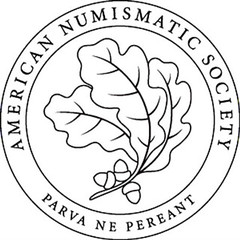 As part of Künker's eLive Auction 87, taking place from May 19-23, 2025, one-hundred coins from the Robert Ronus Collection, which were generously donated to the ANS, will be auctioned off to benefit the Society. ANS Trustee Robert Ronus is a passionate coin collector, a dedicated numismatist, and a long-time supporter of the ANS. The portion of the Ronus Collection up for auction includes some very rare early modern coins from Europe, with a focus on Germany. All pieces are in exquisite condition.
As part of Künker's eLive Auction 87, taking place from May 19-23, 2025, one-hundred coins from the Robert Ronus Collection, which were generously donated to the ANS, will be auctioned off to benefit the Society. ANS Trustee Robert Ronus is a passionate coin collector, a dedicated numismatist, and a long-time supporter of the ANS. The portion of the Ronus Collection up for auction includes some very rare early modern coins from Europe, with a focus on Germany. All pieces are in exquisite condition.
This is the Künker press release about the auction. -Editor
Künker Auctions 100 Pieces from the Ronus Collection to Benefit the American Numismatic Society
As part of eLive Auction 87, taking place from 19 to 23 May 2025, 100 pieces from the Robert Ronus Collection which were generously donated to the ANS will be auctioned off to benefit the Society. Robert Ronus is a passionate coin collector, dedicated numismatist and a long-time supporter of the ANS.
The American Numismatic Society: by Collectors for Collectors and Scholars
The story of the ANS began on 15 March 1858, when a group of coin collectors, at the invitation of 16-year-old Augustus B. Sage, decided to hold regular meetings over numismatics. To this end, they founded the American Numismatic Society. What began as a small group of coin collectors is now one of the most important numismatic institutions in the world.
The ANS has a world-class collection of more than 700,000 numismatic objects and one of the world's most extensive numismatic research libraries comprising more than 100,000 volumes. But the ANS is much more than its holdings: its embrace of modern technology has placed it at the forefront of numismatic digitalization and international networking. A number of special data basis, compiled by numismatists from all over the world at the initiative of the ANS, are now available to all users through the ANS website.
More than twenty employees, including world-renowned numismatists, are at the heart of the ANS. Their salaries, as well as the collection and its infrastructure, are funded entirely by members and sponsors. The ANS receives little to no government funding. Thus, the ANS owes its $5m annual budget entirely to the generosity of its members and sponsors. Without the support of collectors, coin dealers and coin enthusiasts, the ANS would not be able to continue its research and educate the broad public about the importance of numismatics.
Patronage and Numismatics
The ANS is perhaps the largest numismatic organization funded entirely by private patrons. But it is not the only example of the important role that patronage has traditionally played in numismatics. Particularly noteworthy is the range of social backgrounds of these patrons. In contrast to the fine arts, the collector base of the numismatic world is much wider and the interaction between museum curators, collectors and dealers are more intense. Scholars, curators, collectors and dealers meet worldwide in countless small and local clubs, associations and societies to discuss their numismatic passion. In Germany alone, the umbrella organization of numismatic clubs counts more than 70 institutional members.
This close cooperation comes with the advantage that private individuals are well informed about the financial constraints of numismatic institutions. They support "their" institution to the extent of their means and possibilities. This can range from small items of infrastructure such as a second-hand coin box, to grants for printing important numismatic works, or the financing of major acquisitions. Each and every patron is important, regardless of whether their means allow them to contribute a small or a large sum.
The Ronus Collection as the Most Recent Example
The Ronus Collection is therefore just the most recent example of the great commitment that coin collectors continue to demonstrate to keep the numismatic field alive. Ulrich Künker comments: "Many coin collectors see themselves as part of a large international community, and they want to give something back to this community. We at Künker are delighted to be able to support this. I hope that as many people as possible take part in this auction and buy coins from the Ronus Collection. Because every euro spent on one of these coins will benefit the ANS and thus numismatics."
Coins from the Ronus Collection
The part of the Robert Ronus Collection to be auctioned in Künker's eLive Auction 87 from 19 to 23 May includes some very rare early modern coins from Europe, with a focus on Germany. All pieces are in exquisite condition. The collector also paid attention to the quality of the minting and the patina. None of the pieces are graded or slabbed, as is often the case in the USA.
All pieces can be viewed on the Künker auction platform www.kuenker.de. There is no printed auction catalog.
6607 Great Britain. William IV. Crown 1831, London. Only 100 specimens minted. Proof, minimally worn. Estimate: 10,000 euros.
6730 Russia. Ivan III. Rouble 1741, St. Petersburg. Very rare. Extremely fine. Estimate: 7,500 euros.
7447 Prussia. Frederick II. Speciestaler 1741, Berlin. Very rare. Splendid patina. Extremely fine. Estimate: 7,500 euros
7932 Freiburg. Taler 1713. Extremely rare. Very fine +. Estimate: 7,500 euros
To read the complete article, see:
Robert Ronus Collection at Künker, May 19-23
(https://numismatics.org/robert-ronus-collection-at-kunker-may-19-23/)
For more information, or to bid, see:
https://www.kuenker.de/auctions/f06530f157e24e1690e278f4bbee72d0
NOMOS TO SELL COLLIER COLLECTION FOR ANS
The collection of Prof. James M. Collier is being sold by Nomos AG to benefit the Collier Prize in Ancient Numismatics offered by the American Numismatic Society. -Editor
The American Numismatic Society is pleased to announce that the Collection of James M. Collier is currently at auction by Nomos AG in Nomos 35 and Obolos 37. For Nomos 35, pre-bidding Part I will close on June 15, 2025 at 09:00 CEST (3:00 AM ET), and pre-bidding Part II will close on June 16, 2025 at 09:00 CEST (3:00 AM ET). For Obolos 37, Part I will close on May 17, 2025 at 16:00 CEST (10:00 AM ET), and Part II will close on May 18, 2025 at 16:00 CEST (10:00 AM ET). All proceeds from the collection will establish an endowment at the ANS to offer the Collier Prize in Ancient Numismatics in perpetuity.
The Collier Prize was established in 2020 with the generous support of ANS Trustee Carole Anne Menzi Collier in honor of her late husband Professor James M. Collier. It is the most substantial financial award supporting scholarship in ancient numismatics. The auctions will include many fine examples of ancient Greek, Roman, and Byzantine coins from the Collier collection. The auctions are now live at nomosag.com/auction.
James Collier initially taught art history before fully dedicating himself to painting, in which he drew inspiration both from the rich tapestry of art history, but also from the world around him. His work is deeply influenced by his understanding of artistic periods, in particular of the Renaissance, yet he remained attuned to the nuances of objects he loved, such as coins and medals, blending the two to create a unique and compelling visual narrative. His coin collection contains many of the great highlights of ancient numismatics, such as an exceptional group of coins of Syracuse, including a stunning decadrachm of Euainetos (lot. 169). In the extensive Roman series, there are many highlights, such as a remarkable specimen of the sesterius of Nero with his lost triumphal arch (lot 659) and a full set of the twelve Caesars in silver (lot. 640).
The Collier Prize is awarded biennially to the best single or multi-authored work in the field of ancient numismatics, with the winner(s) receiving $20,000 (to be split equally for a multi-authored work). The prize was first awarded in 2021 to Roman Imperial Coinage (RIC) II.3 (Spink, 2020) by Richard Abdy and Peter Mittag, and most recently to Moneda Ibérica (monedaiberica.org), developed and edited by Manuel Gozalbes Fernández de Palencia, Pere Pau Ripollès Alegre, Alejandro Peña, and Juan Francisco Onielfa.
The Sydney F. Martin Executive Director, Dr. Ute Wartenberg Kagan, commented on the auction: "We are most grateful for the generous support of our trustee, Carole Anne Menzi Collier, and Nomos AG for hosting this auction. The proceeds will help the ANS continue to enrich the study of ancient numismatics by supporting this prize and honoring significant research publications in the field."
To read the complete article, see:
Now Live: The Collection of Prof. James M. Collier at Nomos AG
(https://numismatics.org/collier-auction-live/)
For more information, or to bid, see:
https://www.nomosag.com/auction
VULCAN ON ANCIENT COINS
Mike Markowitz published a new CoinWeek article about Vulcan on ancient coins. Here's an excerpt - see the complete article online. -Editor
TO THE ANCIENT Greeks, he was Hephaistos. To the Romans, he was Vulcan. To the Etruscans, he was Sethlans. Many ancient cultures imagined a god of fire who presided over volcanoes and was a metalsmith who crafted magical armor and weapons. Of the 12 "Olympian" gods of the Greco-Roman pantheon, he appears on the fewest coins — a special challenge for collectors eager to assemble a "complete" type set of deities.
The eminent Belgian numismatist François de Callataÿ tabulated the frequency of Greek gods and heroes on coins in a major collection (de Callataÿ, 118). Zeus topped the list with 14,019 appearances, Athena with 7,503, and Apollo with 3,634. Poor Hephaestus appeared on 20.
Hephaestus on the Coins of Lipara
The seven volcanic Aeolian islands off the northern coast of Sicily were settled by Greek colonists as early as 600 BCE. Lipara, the largest island, issued bronze coins bearing what may be the earliest numismatic appearance of Hephaestus dated to c. 440 – 420 BCE. He wears the pilos (Latin: pileus), a conical leather cap worn by smiths to keep sparks from the forge from setting their hair on fire.
On a bronze coin of Lipara dated to c. 350 – 300 BCE, we see Hephaestus seated at his anvil, holding his hammer and an unfinished drinking vessel.
Aesernia
Samnites were a people of south-central Italy conquered by the Romans in a long series of wars from 343 to 290 BCE. Established as a Roman colony in 264 BCE, the Samnite town of Aesernia issued coins bearing the youthful head of Vulcan with one of his attributes, the tongs, used to handle hot metal.
Valerian
Born to an elite senatorial family about 199 CE, Publius Licinius Valerianus rose to command an army that proclaimed him Emperor after Trebonianus Gallus was assassinated by his troops in 253. During his seven-year reign, he issued a variety of coins of remarkably poor workmanship honoring Roman gods. A silvered bronze antoninianus from the mint of Colonia Agrippinensis (today Köln, Germany) depicts Vulcan standing in a temple, holding his hammer and tongs. The Latin inscription DEO VOLCANO simply states "to the god Vulcan". At just $45, this common type was the most affordable coin I found for this god.
To read the complete article, see:
God of Fire: Hephaestus and Vulcan on Ancient Coins
(https://coinweek.com/god-of-fire-hephaestus-and-vulcan-on-ancient-coins/)
SEDE VACANTE COINS
While the world waited for white smoke from the Sistine Chapel, the Catholic Church was without a Pope. In a little-known practice, coins have been issued to commemorate the (usually, but not always) short period in-between Popes - Sede Vacante coinages, or "Vacant Seat". Thanks to Nick Graver for suggesting the topic, although I wasn't able to pull this together for last week's issue while we were still in the latest interregnum period. Numismatic News had a nice article by Mark Benvenuto about this. Here's an excerpt - see the complete article online. -Editor
Collectors of world coins are aware that when a monarch passes away, the design of the coins of that nation usually changes the very next year. The recent example of which most of us are aware is the passing of Queen Elizabeth and the ascension of King Charles to the throne of the United Kingdom of Great Britain and Northern Ireland. The queen's face graced the coins of Great Britain through 2022, and the new king took the spot in 2023. But there is one nation, albeit a tiny one, for which the death of the man on the coins means his face is immediately removed – the Vatican.
Vatican City is the smallest nation, with an area of 109 acres, all surrounded by the city of Rome. This tiny nation represents the last territory of what was once called the Papal States, which used to be a formidable area in the center of Italy up until 1870. For quite a long time, the Vatican issued lire coins that were in lockstep with those of Italy. After the switch to Euros, the Vatican changed, again keeping in stride with Italy.
Curiously, when a pontiff passes away, as Pope Francis did on Easter Monday, April 21, the Vatican changes its coinage to the Sede Vacante pieces. The term is Latin for "Vacant Seat." The image, which shows the prominent symbols of the pope, such as the keys of Saint Peter, but not any face, remains on the coins until the world has another pope.
To read the complete article, see:
Between One Pope and the Next – the Sede Vacante Coins
(https://www.numismaticnews.net/between-one-pope-and-the-next-the-sede-vacante-coins)
Here's an excerpt from a Vatican News story. -Editor
The current Sede Vacante presents several similarities with the one of 1700. That year, Pope Innocent XII passed away before the Holy Year he proclaimed concluded, leaving the Church without its Pastor.
Pope Innocent XII, known for his frail health in later years, suffered from podagra, a form of rheumatic illness that prevented him from personally opening the Holy Door at Christmas in 1699. He died on September 27, 1700, at the age of 85. His death ushered in a nearly two-month period of Sede Vacante before the election of his successor, Pope Clement XI, on November 23.
To commemorate the nearly two months of vacancy in the Chair of Peter, a coin was minted and is now displayed in the medal collection of the Vatican Apostolic Library. On its reverse, the dove of the Holy Spirit is depicted with the Latin verse from the Gospel of John: Non vos relinquam orphans, meaning "I will not leave you orphans" (John 14:18).
"It refers to the death of Innocent XII but also conveys a clear message of hope for the Conclave that was soon to begin," explains to Vatican News Professor Eleonora Giampiccolo, Director of the Numismatics Department of the Vatican Library.
The coins and medals preserved in the Numismatics Department of the Vatican Library carry a powerful communicative force: "They were essential means of communication. The images on them were understandable even to those who couldn't read," the scholar says. "A coin is also a means of exchange, while a medal is primarily a document, a medium of communication. It becomes a document for us, the scholars of posterity."
To read the complete article, see:
Sede Vacante and Jubilee: historical parallels with the Jubilee of 1700
(https://www.vaticannews.va/en/vatican-city/news/2025-05/sede-vacante-and-jubilee-historical-parallels-with-the-jubilee.html)
Minting coins takes time, and I haven't found any references or announcements yet for 2025 Sede Vacante coinage. Let me know if you see any! But printing stamps can be much faster, and here's the Vatican press release on the 2025 Sede Vacante stamps. -Editor
The Vatican City State announces that the commemorative stamps of the Sede Vacante MMXXV (2025) for postage use are on sale at the Vatican Post Offices, including the general public accessible sales points located in St. Peter's Square.
The philatelic series of the Sede Vacante MMXXV will also be available soon with a print run in line with market demand through the e-shop sales channels of the Commercializzazione Filatelica e Numismatica office, which will be reactivated this summer.
The stamps are divided into four postal values (€ 1.25 - € 1.30 - € 2.45 - € 3.20) and will be sold at their relative face value.
To read the complete article, see:
PRESS RELEASE POSTAGE STAMPS SEDE VACANTE MMXXV
(https://www.vaticanstate.va/en/news/1850-press-release-postage-stamps-sede-vacante-mmxxv.html)
Thanks also to #1 Money Man for this image of the Robert Bashlow "In the Pope We Hope" satirical piece. -Editor
For more background on Wikipedia, see:
https://en.wikipedia.org/wiki/Sede_vacante
To read earlier E-Sylum Sede Vacante articles, see:
MORE ON TRANSITIONAL PAPAL COINAGE
(https://coinbooks.org/esylum_v08n15a03.html)
VATICAN RELEASES PLANS FOR 2013 SEDE VACANTE COINS
(https://www.coinbooks.org/esylum_v16n09a24.html)
NEWMAN PORTAL SEARCH: 1719 SEDE VACANTE
(https://www.coinbooks.org/v21/esylum_v21n22a12.html)
To read the earlier E-Sylum articles on the Bashlow pieces, see:
MORE ON THE BASHLOW KENNEDY POPE SATIRE MEDAL
(https://www.coinbooks.org/v20/esylum_v20n36a11.html)
MORE BASHLOW PRODUCTIONS
(https://www.coinbooks.org/v25/esylum_v25n21a13.html)
ROBERT BASHLOW, PART TWO
(https://www.coinbooks.org/v25/esylum_v25n19a16.html)
HOBO NICKEL FLAPPER CARVINGS
The Spring 20205 issue of Bo Tales from the Original Hobo Nickel Society has a nice article by Barry Homrighaus on "Flapper Carvings" - nickels sculpted to depict the fashionable young women "flappers" of the early 20th century. With permission we're publishing an excerpt below. Thank you! See the complete issue for more. -Editor
Most classic hobo nickels depict bearded gents in derby hats. Classic carvers also portrayed and often satirized lots of other male characters; Irishmen, Chinamen, Rabbis, Shriners, Uncle Sam, Honest Abe, etc. But ladies on hobo nickels are exceedingly rare.
Only thirty-eight images of women can be found among the more than 2,800 classic carvings (i.e. carvings on Buffalo nickels made before 1982) in the OHNS archives. Three of these thirty-eight are women with artfully-styled long hair, carved by "Bert" Wiegand. Twenty-six more are attributed to "Bo" Hughes, mostly images of his lover "Monique." Of the remaining nine portraits of women in the archives, eight are Flappers, and it was these eight which initially caught my interest. Subsequent research located four more Flappers in private collections which having never been the subject of a QD examination cannot be found in the archives.
The birth of the "flappers" in America can be traced to the early years of the 20th century, when popular media began to showcase women with boyish figures, slinky dresses, and short, "girlish" hair. But the flapper image was not just a style, it was a statement. Flappers challenged the social norms of their day with scandalous clothing, quirky hairstyles, and shocking behavior. They chain-smoked cigarettes and drank gin, and were "all the rage" in Hollywood.
The most iconic feature of the flapper's style was short or "bobbed" hair. It could be a straight, blunt cut known as a "Dutch bob," or curled up around the cheek as in the "coconut bob," or styled with "finger waves" or "spit curls." While only a few of the flappers are remembered by name today - Clara Bow and Josephine Baker come to mind - as a generation of young women redefining their role in society, they have not been forgotten.
Only the best hobo nickel carvers made extensive modifications to the profile. It was easier for a less skilled artist to simply add a beard and mustache and otherwise leave the facial features alone. The complete transformation of the face of Flapper #1 showcases the work of a master carver.
Flapper #4 must have looked familiar to Del Romines, even if he had never seen that particular coin before, because it was an almost perfect match to Flapper #5, the coin with the inscription "JK 1921" which had graced the cover of his first book, Hobo Nickels, in 1982.
Romines graded Flapper #4 Superior, and his familiarity with Flapper #5 was evident when he described #4 as, "Possibly part of a series which was originally thought to have been carved by a female. A ‘JK 1921' and ‘JT 1919' coins are pictured on page 35 in the hobo nickel book, and are very similar…to this carving." [my emphasis].
With these comments, the original thought that a woman had carved the Flappers was dismissed. Instead, Romines asserted that Flapper #4, and by implication its twin #5, were "possibly… by Bo." After October 1995, through decades of subsequent QD reports and articles written by hobo nickel experts, the theory of a female hobo nickel carver never appeared again.
For more information on the Original Hobo Nickel Society, see:
https://www.hobonickels.org/
WAR MUSEUM EXTENDS VICTORIA CROSS EXHIBIT
Britain's Imperial War Museum has extended through the end of September their impressive exhibit of Victoria Cross and George Cross medals lent by Lord Ashcroft. -Editor
Imperial War Museums bosses have performed a partial U-turn on their controversial decision to close the Lord Ashcroft Gallery at the end of the month
Thousands more people can see the world's largest collection of Victoria Cross and George Cross medals in a victory for Britain's "bravest of the brave". War heroes took a stand outside the Imperial War Museum in London last week in protest over the venue's plans to remove their gallantry gongs from public display at the end of this month to make way for exhibitions about post-World War II conflicts.
Iraq War hero Johnson Beharry, 45, the first living soldier in almost 50 years to be awarded the VC, was among veterans who slammed moves to close the "stunning" exhibition as the nation commemorated the 80th anniversary of VE Day.
Lord Ashcroft has gathered 240 VCs, the highest military decoration awarded in the United Kingdom, as well as 42 George Crosses, the highest civilian gallantry award. The first Victoria Cross was awarded in 1856 by Queen Victoria. The George Cross is bestowed on those who have displayed the greatest heroism or the most conspicuous courage while in extreme danger. Only 418 have been awarded since 1940.
Now museum bosses have retreated on their decision and agreed to keep the Lord Ashcroft Gallery, home to the Extraordinary Heroes exhibition, open until the end of September after he threatened legal action. The "common sense" decision to keep the gallery open to the public for a little longer was welcomed by Lord Ashcroft, a businessman, philanthropist and former deputy chairman of the Tory Party.
But the Imperial War Museum seems intent on carrying through with its decision to close the exhibit. Stay tuned to the saga - time will tell the fate of the collection. -Editor
To read the complete article, see:
Museum retreats in medal row in 'important victory for common sense'
(https://www.express.co.uk/news/uk/2053110/IWM-Medal-Gallery-Lord-Ashcroft)
See also:
Imperial War Museum makes temporary U-turn on Victoria and George Cross exhibition
(https://www.forcesnews.com/heritage/history/lord-ashcroft-gallery-stay-open-until-september-after-imperial-war-museum-changes)
Imperial War Museum U-turns on decision to axe Victoria Cross display
(https://www.telegraph.co.uk/news/2025/05/09/imperial-war-museum-u-turns-decision-pull-victoria-cross/)
To read the earlier E-Sylum articles, see:
MUSEUM TO CLOSE VICTORIA CROSS EXHIBIT
(https://www.coinbooks.org/v28/esylum_v28n09a27.html)
VENUES VIE FOR ASHCROFT VICTORIA CROSSES
(https://www.coinbooks.org/v28/esylum_v28n11a21.html)
MOTHER'S DAY NUMISMATICS
E-Sylum readers love history, and I thought I'd first share this interesting background on Mother's Day from Garrison Keillor's Writer's Almanac. -Editor
It's the second Sunday in May, which is Mother's Day here in the United States. It's Mother's Day in other countries, too, including Denmark, Italy, Venezuela, Turkey, Australia, and Japan.
A woman named Anna Jarvis was the person behind the official establishment of Mother's Day. Her mother, Anna Reeves Jarvis, had a similar idea, and in 1905 the daughter swore at her mother's grave to dedicate her life to the project. She campaigned tirelessly for the holiday. In 1907, she passed out 500 white carnations at her mother's church, St. Andrew's Methodist Episcopal Church in Grafton, West Virginia — one for each mother in the congregation. In 1912, West Virginia became the first state to adopt an official Mother's Day, and in 1914 President Woodrow Wilson made it a national holiday.
Anna Jarvis became increasingly concerned over the commercialization of Mother's Day. She said, "I wanted it to be a day of sentiment, not profit." She was against the selling of flowers, and she called greeting cards "a poor excuse for the letter you are too lazy to write." Nevertheless, Mother's Day has become one of the best days of the year for florists. When Anna Jarvis lived the last years of her life in nursing home without a penny to her name, her bills were paid, unbeknownst to her, by the Florist's Exchange.
Getting to the numismatics of this day, I thought I'd share a Pocket Change blog by Matthew Wittman of the American Numismatic Society that we excerpted back in 2015. Happy Mother's Day, Moms! -Editor
With Mother's Day approaching this weekend, I thought it might be a good time for a post about the many mothers who appear in the collection of the American Numismatic Society. The most common way mothers figure in our collections is via medallic art, where prominent artists ranging from Oscar Roty (1846-1911) to Victor David Brenner (1871-1924) engraved medals depicting maternal ideals. Roty's particularly elegant medal was executed as a memorial of the baptism of his son in 1893.
Brenner's medal follows Roty rather closely and indeed much of the medallic art concerning motherhood in the Beaux-Arts era traded in these kind of sentimental images.
One exceptional item to note in this context is a wonderful medallion by Adam Pietz (1873-1961) that depicts his own mother in a realistic rather than an idealized fashion. (I should also note that the ANS has a small archive of his drawings, photographs, and papers.)
In 1914, a proclamation by Woodrow Wilson officially set aside the "second Sunday of May as a public expression of our love and reverence for the mothers of our country." He did so as a result of long-running campaign by activist Anna Jarvis to honor the memory of her own mother and the ideal of motherhood more generally. The holiday subsequently spread around the world, in some places combining with existing traditions.
Mother's Day took on a special significance in the context of World War I when so many mothers had sons fighting and dying overseas. See the Art of Devastation project for the many ways that mothers featured in the often grim medallic art and propaganda that accompanied the war.
Here's a non-medallic item we didn't excerpt earlier. I also added images of the Brenner medal above which was linked but not pictured in the ANS blog article. -Editor
On the other hand, mothers have appeared only very sparingly in circulating currency. While there is a lot of Byzantine and medieval coinage that features religious iconography of the Virgin Mary with child, more specific and secular representations of motherhood have been few and far between. A notable exception to this rule was the Obsolete Bank Note Era (1782-1866) in the United States, when images of mothers and childhood proliferated. This was not coincidentally a time when modern ideas about childhood and the nurturing role of the mother in particular were coming to the fore.
To read the complete article, see:
Mother's Day Numismatics
(https://numismatics.org/pocketchange/mothers-day-numismatics/)
To read the Writer's Almanac article, see:
Sunday May 11, 2014
(https://writersalmanac.publicradio.org/index.php%3Fdate=2014%252F05%252F11.html)
To read the earlier E-Sylum article, see:
MEDALS FOR MOTHERS
(https://www.coinbooks.org/esylum_v18n19a40.html)
UNEXCHANGED SWISS BANKNOTE FUNDS
Kavan Ratnatunga passed along this article about unexchanged obsolete Swiss banknotes. Thanks. -Editor
Switzerland's central bank said today (May 9) that it would hand over to the government an emergency relief fund cash that had previously been earmarked for the exchange of old banknotes.
The Swiss National Bank (SNB) is to transfer a total of Sfr890.6 million ($1.07 billion) that was set aside for the exchange of sixth-series banknotes, which ceased to be legal tender in 2000. The bank said the Sfr890.6 million amounted to 90% of the value of the notes that had not been exchanged by April 30.
A total of CHF178.1 million will be paid to the Swiss Fund for Assistance in the Event of Uninsurable Natural Disaster Damage (fondssuisse). Two-thirds of the remaining money will go to the cantons (CHF475 million) and one-third to the federal government (CHF237.5 million), according to the press release.
The distribution of the money is governed by the Federal Act on Currency and Payment Instruments. It stipulates that 25 years after the recall of a banknote series, the equivalent value of the banknotes that have not been exchanged will be allocated according to a distribution formula. The SNB said the beneficiaries will be paid in May 2025.
To read the complete article, see:
SNB to hand out cash earmarked for exchange of defunct notes
(https://www.centralbanking.com/central-banks/currency/banknotes/7972854/snb-to-hand-out-cash-earmarked-for-exchange-of-defunct-notes)
A total of CHF178.1 million will be paid to the Swiss Fund for Assistance in the Event of Uninsurable Natural Disaster Damage (fondssuisse). Two-thirds of the remaining money will go to the cantons (CHF475 million) and one-third to the federal government (CHF237.5 million), according to the press release.
The distribution of the money is governed by the Federal Act on Currency and Payment Instruments. It stipulates that 25 years after the recall of a banknote series, the equivalent value of the banknotes that have not been exchanged will be allocated according to a distribution formula. The SNB said the beneficiaries will be paid in May 2025.
To read the complete article, see:
Swiss authorities profit from unexchanged banknotes
(https://www.swissinfo.ch/eng/various/confederation-and-cantons-profit-from-banknotes-that-are-not-exchanged/89291798)
LOOSE CHANGE: MAY 11, 2025
Here are some additional items in the media this week that may be of interest. -Editor
Michael Garofalo published a nice Greysheet article on sculptor Adolph Weinman. Here's an excerpt - see the complete article online. -Editor
Although he was a member of the American Numismatic Society, Weinman did not actually consider himself to be a coin designer or medalist. Weinman often referred to himself as a sculptural artist.
In fact, the Mercury Dime and the Walking Liberty Half Dollar are Weinman's only successful coin designs. However, his son, Howard Weinman, did design an American coin that was struck by the United States Mint. He designed the 1936 Long Island Tercentenary Commemorative Half Dollar. That, too, was Howard's only successful coin design.
Beyond the sculpture and the sculptural fountains for the 1904 St Louis World's Fair and the 1915 Panama-Pacific International Exposition, Adolph Weinman also created a number of statues of Abraham Lincoln in the states of Wisconsin and Kentucky. He created a figural statue for the Bronx County Court House in New York City, executed sculptures in Washington, D.C. for the Post Office Department Building and figural sculptures for the National Archives Building, created the ‘Drafting of the Declaration of Independence' inside the Jefferson Memorial, and for the United States Supreme Court, Weinman created friezes portraying ‘Lawgivers of History,' ‘Majesty of Law,' ‘Power of Government,' and ‘Powers of Good, Powers of Evil.'
Well worth a read. I enjoyed seeing the image of Weinman's 1916 Walking Liberty Half Dollar Pattern. -Editor
To read the complete article, see:
Adolph Weinman: Master Sculptor
(https://www.greysheet.com/news/story/adolph-weinman-master-sculptor)
ABOUT THIS ISSUE: MAY 11, 2025
Not much worth mentioning this week that didn't already go into this issue. I was at the movies again this week - my boys and I went to see the 50th anniversary showing of "Monty Python and the Holy Grail". We enjoyed it, and it held up well. I guess supreme silliness never goes out of season.
I couldn't find a numismatic connection anywhere, but I suppose for bibliophiles there's the Book of Armaments (and the Holy Hand Grenade of Antioch). -Editor
Wayne Homren
Wayne Homren is the founding editor of The E-Sylum and a consultant for the Newman Numismatic Portal. His collecting interests at various times included U.S. Encased Postage Stamps, merchant counterstamps, Pittsburgh Obsolete paper money, Civil War tokens and scrip, Carnegie Hero Medals, charge coins and numismatic literature. He also collects and has given presentations on the work of Money Artist J.S.G. Boggs. In the non-numismatic world he's worked in artificial intelligence, data science, and as a Program Manager for the U.S. Department of Defense.
Garrett Ziss
Garrett Ziss is a numismatic collector and researcher, with a focus on American paper money and early U.S. silver and copper coins. He is also a part-time U.S. coin cataloger for Heritage Auctions. Garrett assists Editor Wayne Homren by editing and formatting a selection of articles and images each week. When he's not engaged in numismatics, Garrett is a Senior Honors student at the University of Pittsburgh.
Pete Smith
Numismatic researcher and author Pete Smith of Minnesota has written about early American coppers, Vermont coinage, numismatic literature, tokens and medals, the history of the U.S. Mint and much more. Author of American Numismatic Biographies, he contributes original articles to The E-Sylum often highlighting interesting figures in American numismatic history.
Greg Bennick
Greg Bennick (www.gregbennick.com) is a keynote speaker and long time coin collector with a focus on major mint error coins and US counterstamps. He is on the board of both CONECA and TAMS and enjoys having in-depth conversations with prominent numismatists from all areas of the hobby. Have ideas for other interviewees? Contact him anytime on the web or via instagram
@minterrors.
John Nebel
Numismatist, photographer, and ANS Board member and Fellow John Nebel of Boulder, CO helped the ANA and other clubs like NBS get online in the early days of the internet, hosting websites gratis through his Computer Systems Design Co. To this day he hosts some 50 ANA member club sites along with our
coinbooks.org site, making the club and our E-Sylum archive available to collectors and researchers worldwide.
Bruce Perdue
Encased coinage collector (encasedcoins.info) Bruce Perdue of Aurora, Illinois has been the volunteer NBS webmaster from its early days and works each week to add the latest E-Sylum issue to our archive and send out the email announcement.

